Sunday, 13th May 2018
I awoke on Sunday to find it raining although not cold. The hills were shrouded in mist. As arranged, morning tea was served in my lodge at 6.30 a.m. Breakfast was available in the main lodge between seven and nine and the rain had stopped when I went up the stone path for my meal. The stillness of the mountain top location was very relaxing and, after breakfast, I was quite happy to wander around the main lodge, studying the layout.
An engraved brass plate commemorated those involved in the creation of the lodge, which was opened by Sir Edmund Hillary in 1998 and has since hosted Prince Charles and Princess Anne.
During the day, the mist lifted and it was pleasantly warm, but without the bright sunshine of the previous day. After lunch, one of the guides induced me to take a short trek with him to the nearby village, although I was a bit worried about the terrain and my impaired mobility. I armed myself with a wooden stick from the lodge (albeit rather long for me) and we safely completed the walk, including a rather stiff climb up a hill to a viewpoint which I'd seen from my lodge. At the viewpoint was an abandoned house, now used as a rendezvous by the young people of the district. We also met my guide's wife, who was displaying jewellery and artefacts.
In the evening, the same friendly group of four dined together. I'd enjoyed the day immensely, although not done a lot. I retired a little earlier than the previous night but was woken up during the night by the crashing thunder of a furious thunderstorm.
Related posts on this website
This is one of a series of posts describing my first visit to Nepal. Clicking on the 'Next report' link displays the post describing the next events. In this way, you may read about the trip in sequence.
Next report.
Alternately, clicking on the 'All my Nepal reports' link displays all the posts on this trip in reverse date-of-posting order.
All my Nepal reports.
My pictures
Tiger Mountain Pokhara Lodge
Trek at Tiger Mountain Pokhara Lodge, 13th May 2018
All my pictures on this trip to Nepal can be found in the collection Nepal.
[Pictures linked 8-Aug-2018]
Tuesday 15 May 2018
Returning Home
Tuesday, 15th May 2018
I'll describe my journey back to Kathmandu and my sightseeing in nearby Bhaktapur City on Monday, 14th June when I can.
After a comfortable night at Dwarika's, I'm about to set off on the long journey home. It should be Qatar Airways A320 to Doha on the QR649, transiting to a 787-8 on flight QR023 to Manchester. The last few weeks have certainly earned the title 'Journey of a lifetime'.
Related posts on this website
This is one of a series of posts describing my first visit to Nepal. Clicking on the 'Next report' link (where shown) displays the post describing the next events. In this way, you may read about the trip in sequence.
Alternately, clicking on the 'All my Nepal reports' link displays all the posts on this trip in reverse date-of-posting order.
All my Nepal reports.
Clicking on the 'All my Burma-2018 reports' link displays all the posts on my time in Myanmar prior to arriving in Nepal, again in reverse date-of-posting order.
All my Burma-2018 reports.
My pictures
Tiger Mountain Pokhara Lodge
Tiger Mountain, Pokhara, Nepal
Pokhara, Nepal
Pokhara to Kathmandu by Buddha Air Beech 1900D
Kathmandu Airport
Kathmandu
Dwarika's Hotel, Kathmandu
Bhaktapur City, Nepal Nepal from above
All my pictures on this trip to Nepal can be found in the collection Nepal.
[Pictures linked 8-Aug-2018]
I'll describe my journey back to Kathmandu and my sightseeing in nearby Bhaktapur City on Monday, 14th June when I can.
After a comfortable night at Dwarika's, I'm about to set off on the long journey home. It should be Qatar Airways A320 to Doha on the QR649, transiting to a 787-8 on flight QR023 to Manchester. The last few weeks have certainly earned the title 'Journey of a lifetime'.
Related posts on this website
This is one of a series of posts describing my first visit to Nepal. Clicking on the 'Next report' link (where shown) displays the post describing the next events. In this way, you may read about the trip in sequence.
Alternately, clicking on the 'All my Nepal reports' link displays all the posts on this trip in reverse date-of-posting order.
All my Nepal reports.
Clicking on the 'All my Burma-2018 reports' link displays all the posts on my time in Myanmar prior to arriving in Nepal, again in reverse date-of-posting order.
All my Burma-2018 reports.
My pictures
Tiger Mountain Pokhara Lodge
Tiger Mountain, Pokhara, Nepal
Pokhara, Nepal
Pokhara to Kathmandu by Buddha Air Beech 1900D
Kathmandu Airport
Kathmandu
Dwarika's Hotel, Kathmandu
Bhaktapur City, Nepal Nepal from above
All my pictures on this trip to Nepal can be found in the collection Nepal.
[Pictures linked 8-Aug-2018]
Monday 14 May 2018
Tiger Mountain Pokhara Lodge
Saturday, 12th May 2018
The main building of the Tiger Mountain Pokhara Lodge is large, single-storey, stone built, with lots of glazed doors which give access to an open terrace with superb views over the valley below with snow-clad mountains in the background. At one end of the building, the kitchen is at a lower level, forming a basement area. There were lots of male staff in attendance, all English speakers.
"Your lunch is ready", they announced, setting a brass tray with lots of small dishes and rice at a table on the terrace. It was Nepali-style cooking. I enjoyed what I was able and then, no doubt to the disappointment of the Chef, arranged that I would stick to bland, European-style food for the rest of my stay.The sun was warm and visibility good that afternoon: thereafter it remained cool with moderate to poor visibility, for which they apologised. But I enjoyed the ever-changing, rather mysterious views of mist-shrouded mountains.
I believe they have 19 lodges for guests. Appropriately, I was given number 7, the nearest to the main lodge, which still involved a flight of stone steps and a steep path rough-hewn into the living rock. My lodge was well-appointed with a very large double bed and a single bed. I selected the double bed. A section at one end of the lodge had a shower, wash handbasin and W.C. A covered terrace outside the front door was furnished with a table, easy chair and staggering views across the valley. I knew I would enjoy my brief stay.
After my early start that day to take the Mountain Flight from Kathmandu, I was happy to spend the rest of the afternoon in my room backing up photographs and preparing text offline for the blog. I was told that dinner was 'seven for seven-thirty' and found, because it was near the end of the season, only two other guests, Hannah and Oliver Knight, a young couple from London. Our host was the English manager of the lodge, and we dined together very agreeably at a table for four set up in an annexe to the large dining room. I'd remembered to bring the wind-up torch from my room to light my unsteady way back to my room, but the path was also lit by a number of paraffin Hurricane lamps which produced a nostalgic aroma. Exhausted, I slept well.
Related posts on this website
This is one of a series of posts describing my first visit to Nepal. Clicking on the 'Next report' link displays the post describing the next events. In this way, you may read about the trip in sequence.
Next report.
Alternately, clicking on the 'All my Nepal reports' link displays all the posts on this trip in reverse date-of-posting order.
All my Nepal reports.
My pictures
Tiger Mountain Pokhara Lodge
All my pictures on this trip to Nepal can be found in the collection Nepal.
[Pictures linked 8-Aug-2018]
The main building of the Tiger Mountain Pokhara Lodge is large, single-storey, stone built, with lots of glazed doors which give access to an open terrace with superb views over the valley below with snow-clad mountains in the background. At one end of the building, the kitchen is at a lower level, forming a basement area. There were lots of male staff in attendance, all English speakers.
"Your lunch is ready", they announced, setting a brass tray with lots of small dishes and rice at a table on the terrace. It was Nepali-style cooking. I enjoyed what I was able and then, no doubt to the disappointment of the Chef, arranged that I would stick to bland, European-style food for the rest of my stay.The sun was warm and visibility good that afternoon: thereafter it remained cool with moderate to poor visibility, for which they apologised. But I enjoyed the ever-changing, rather mysterious views of mist-shrouded mountains.
I believe they have 19 lodges for guests. Appropriately, I was given number 7, the nearest to the main lodge, which still involved a flight of stone steps and a steep path rough-hewn into the living rock. My lodge was well-appointed with a very large double bed and a single bed. I selected the double bed. A section at one end of the lodge had a shower, wash handbasin and W.C. A covered terrace outside the front door was furnished with a table, easy chair and staggering views across the valley. I knew I would enjoy my brief stay.
After my early start that day to take the Mountain Flight from Kathmandu, I was happy to spend the rest of the afternoon in my room backing up photographs and preparing text offline for the blog. I was told that dinner was 'seven for seven-thirty' and found, because it was near the end of the season, only two other guests, Hannah and Oliver Knight, a young couple from London. Our host was the English manager of the lodge, and we dined together very agreeably at a table for four set up in an annexe to the large dining room. I'd remembered to bring the wind-up torch from my room to light my unsteady way back to my room, but the path was also lit by a number of paraffin Hurricane lamps which produced a nostalgic aroma. Exhausted, I slept well.
Related posts on this website
This is one of a series of posts describing my first visit to Nepal. Clicking on the 'Next report' link displays the post describing the next events. In this way, you may read about the trip in sequence.
Next report.
Alternately, clicking on the 'All my Nepal reports' link displays all the posts on this trip in reverse date-of-posting order.
All my Nepal reports.
My pictures
Tiger Mountain Pokhara Lodge
All my pictures on this trip to Nepal can be found in the collection Nepal.
[Pictures linked 8-Aug-2018]
On to Pokhara
Saturday, 12th May 2018
The late running of my early morning Mountain Flight meant that I had less time than planned for breakfast at Dwarika’s Hotel but I had an omelette, tomato juice and tea provided promptly by the attentive staff in the restaurant. I had decided to travel light for my trip to Pokhara so I crammed a few clothes in my rucksack with my computer and put two bags in the hotel’s luggage store until my return. At ten o’clock my guide, driver and the writer set off back to the airport I’d so recently left. The police presence was even more intense: police lined both sides of the main road every 50 yards and there were periodic groups of paramilitary ‘riot squads’, supported by lorries marked ‘Mobile Rest Room’.
At Tribhuvan Airport, I now knew the system for embarking on domestic flights. My booking to Polhara was on the noon flight. The pleasant young man who’d earlier issued my boarding pass for the Mountain Flight recognized me and explained that, because flights were disrupted by the VVIP visit, he was booking me on flight U4 609, due to leave at 10:35 but that this would leave late. I went through security and secondary security into the crowded, noisy Gate Area. On the Buddha Air Flight Information screen, many flights, including mine, had the note ‘DELAY DUE TO VVIP MOVEMENT’. Occasionally, painstaking amendments would be made to the display, or the Windows start-up screen would appear for a while or the public screen would shut down and require re-start by a member of staff with a hand-held remote control. Having found a seat with a view of the Flight Information screen, I stayed put. Thus, the morning slowly passed. Around 12:30, my flight was called and passengers filled up a couple of transfer buses. Then we waited. The Thai flight from Bangkok which I’d arrived on the previous day landed, an ATR-62 local flight took off, followed by a twin jet. Then a Malaysia Airlines 737-800 landed and taxied to the stand, followed by a Simrik Airlines local flight. Kathmandu is a very busy airport. After 20 minutes, the bus drove across the apron to the domestic flight line, where we stopped adjacent to a Buddha Air ATR-62 turbo-prop. Another wait followed. Then we boarded the aircraft and there was a further wait whilst the two stewardesses plied us with peanuts, a fruit drink and water. Suddenly, the engines were started, our snacks were hurriedly cleared away and we taxied to the runway.
We rapidly climbed away from Kathmandu, and emerged above the clouds with views of snow-clad peaks brightly lit by the sun on our right. Before long, we descended through the clouds to a plain well covered with buildings – Pokhara is, I think, the second largest city in Nepal after Kathmandu. The approach to Pokhata is interesting. When approach flap was selected, I knew we were getting close to landing, but I couldn’t spot the runway ahead. Then we commenced a steep right bank, turned right and kept turning. As we continued to turn, I saw what appeared to be a new runway under construction further out on the plain. Just before the runway threshold, the pilot levelled out and we made a fairly fast landing. Landing at Pokhara can be quite a challenge for pilots, so I could see why a new airport is being built, presumably with easier approach from the air. We walked from the aircraft to a small baggage hall but with hand baggage only, I was quickly in the small car park looking for the representative from Tiger Mountain Lodge. I located him and we set off in a black Land Rover through the centre of Pokhara, larger than I expected. A straight main road led us through ribbon development for a few kilometres then the scenery became more rural and we turned off the main road onto a steeply-inclined road ascending Tiger Mountain. It soon became clear why we were using a Land Rover as the narrow road twisted and turned up the mountain through a series of tight hairpin bends. An unsurfaced lane led us to a small car park from where we walked up a path cut into the rock and climbed stone steps to enter the main building of Tiger Mountain Lodge, my home for two nights.
Related posts on this website
This is one of a series of posts describing my first visit to Nepal. Clicking on the 'Next report' link displays the post describing the next events. In this way, you may read about the trip in sequence.
Next report.
Alternately, clicking on the 'All my Nepal reports' link displays all the posts on this trip in reverse date-of-posting order.
All my Nepal reports.
My pictures
Nepal from above
Kathmandu Airport
Kathmandu
Dwarika's Hotel, Kathmandu
Pokhara, Nepal
Tiger Mountain, Pokhara, Nepal
Tiger Mountain Pokhara Lodge
All my pictures on this trip to Nepal can be found in the collection Nepal.
[Pictures linked 8-Aug-2018]
The late running of my early morning Mountain Flight meant that I had less time than planned for breakfast at Dwarika’s Hotel but I had an omelette, tomato juice and tea provided promptly by the attentive staff in the restaurant. I had decided to travel light for my trip to Pokhara so I crammed a few clothes in my rucksack with my computer and put two bags in the hotel’s luggage store until my return. At ten o’clock my guide, driver and the writer set off back to the airport I’d so recently left. The police presence was even more intense: police lined both sides of the main road every 50 yards and there were periodic groups of paramilitary ‘riot squads’, supported by lorries marked ‘Mobile Rest Room’.
At Tribhuvan Airport, I now knew the system for embarking on domestic flights. My booking to Polhara was on the noon flight. The pleasant young man who’d earlier issued my boarding pass for the Mountain Flight recognized me and explained that, because flights were disrupted by the VVIP visit, he was booking me on flight U4 609, due to leave at 10:35 but that this would leave late. I went through security and secondary security into the crowded, noisy Gate Area. On the Buddha Air Flight Information screen, many flights, including mine, had the note ‘DELAY DUE TO VVIP MOVEMENT’. Occasionally, painstaking amendments would be made to the display, or the Windows start-up screen would appear for a while or the public screen would shut down and require re-start by a member of staff with a hand-held remote control. Having found a seat with a view of the Flight Information screen, I stayed put. Thus, the morning slowly passed. Around 12:30, my flight was called and passengers filled up a couple of transfer buses. Then we waited. The Thai flight from Bangkok which I’d arrived on the previous day landed, an ATR-62 local flight took off, followed by a twin jet. Then a Malaysia Airlines 737-800 landed and taxied to the stand, followed by a Simrik Airlines local flight. Kathmandu is a very busy airport. After 20 minutes, the bus drove across the apron to the domestic flight line, where we stopped adjacent to a Buddha Air ATR-62 turbo-prop. Another wait followed. Then we boarded the aircraft and there was a further wait whilst the two stewardesses plied us with peanuts, a fruit drink and water. Suddenly, the engines were started, our snacks were hurriedly cleared away and we taxied to the runway.
We rapidly climbed away from Kathmandu, and emerged above the clouds with views of snow-clad peaks brightly lit by the sun on our right. Before long, we descended through the clouds to a plain well covered with buildings – Pokhara is, I think, the second largest city in Nepal after Kathmandu. The approach to Pokhata is interesting. When approach flap was selected, I knew we were getting close to landing, but I couldn’t spot the runway ahead. Then we commenced a steep right bank, turned right and kept turning. As we continued to turn, I saw what appeared to be a new runway under construction further out on the plain. Just before the runway threshold, the pilot levelled out and we made a fairly fast landing. Landing at Pokhara can be quite a challenge for pilots, so I could see why a new airport is being built, presumably with easier approach from the air. We walked from the aircraft to a small baggage hall but with hand baggage only, I was quickly in the small car park looking for the representative from Tiger Mountain Lodge. I located him and we set off in a black Land Rover through the centre of Pokhara, larger than I expected. A straight main road led us through ribbon development for a few kilometres then the scenery became more rural and we turned off the main road onto a steeply-inclined road ascending Tiger Mountain. It soon became clear why we were using a Land Rover as the narrow road twisted and turned up the mountain through a series of tight hairpin bends. An unsurfaced lane led us to a small car park from where we walked up a path cut into the rock and climbed stone steps to enter the main building of Tiger Mountain Lodge, my home for two nights.
Related posts on this website
This is one of a series of posts describing my first visit to Nepal. Clicking on the 'Next report' link displays the post describing the next events. In this way, you may read about the trip in sequence.
Next report.
Alternately, clicking on the 'All my Nepal reports' link displays all the posts on this trip in reverse date-of-posting order.
All my Nepal reports.
My pictures
Nepal from above
Kathmandu Airport
Kathmandu
Dwarika's Hotel, Kathmandu
Pokhara, Nepal
Tiger Mountain, Pokhara, Nepal
Tiger Mountain Pokhara Lodge
All my pictures on this trip to Nepal can be found in the collection Nepal.
[Pictures linked 8-Aug-2018]
Mountain Flight
Saturday, 12th May 2018
To cater for the interest of tourists in the Himalayan mountains and, of course, Mount Everest there are daily flights from Kathmandu airport to view the peaks. The weather can be very changeable so good views and the flights themselves are not guaranteed. There are a number of similar flights each day, all operating early morning to secure the best views.
I was booked with Buddha Air, due to leave at 06:15 but I was warned that flight times are notoriously variable, according to weather conditions. In addition, we had the movements of Indian Prime Minister Mr. Modi to contend with, hence I was picked up by my guide at 4.30 a.m. The guide said the flight would be affected by Mr. Modi’s planned visit to a temple. The flights leave from Tribhuvan Airport where I’d arrived the previous day but there’s a separate Domestic Terminal for internal and ‘Mountain’ flights. The guide wasn’t allowed into the terminal building so he described the arrangements I’d find. First, there was a ticket and passport check, then hand baggage was X-rayed and, after passing through a detector arch, there was a body search (separate for men and women). I was then in a noisy, barn-like Ticket Hall where I found a group of Buddha Air check-in counters, most with a destination board hung up. I queued at the one with the sign ‘MOUNTAIN’ and was issued with a boarding card by a friendly young man who, like a lot of the people I met, spoke good English. I then passed into a crowded waiting area but noticed that many people were passing through a secondary security to what appeared to be the Gate Area. Since there was no passenger information screen in the waiting area, I went through security to an even more crowded, even noisier gate area. There were a couple of fairly standard display screens but the Buddha Air flights weren’t shown.
But near one of the two gates, there was a single counter with a display screen above in a frame marked Buddha Air Flight Information. There were six ‘Mountain’ flights shown, all departing at 06:15. As I watched, the screen started to change, but slowly, one character at a time. To confirm my suspicions, I walked to the side of the counter and there was a screen and keyboard with a girl typing in the day’s schedule from a printed list originated by another system. It rather looked as if she was using Word, Excel or Access to create the schedule and that the public display was simply a second screen on her computer. New entries appeared in a very small font, so each field was laboriously resized individually, with all the option menus appearing on the public display as well. Occasionally, an existing field would be copied to save retyping. I was fascinated watching this lengthy process and realized that all changes throughout the day were going to be made by this labour intensive process. There was a permanent crush of people around the desk, bombarding the girl with questions but I decided that I could probably use the screen as a source of information. Northing else happened for a while, except that more people arrived in the Gate Area. Then all the ‘Mountain’ flights were bracketing together on the display with the ominous message ‘AIRPORT CLOSED DUE TO VVIP MOVEMENT’. Initially, the girl had type ‘VIP’ but one of her colleagues suggested that she amend it to read ‘VVIP’. To get the remark in red characters, she had to use another sub menu to select colour. A few minutes later the message was amended to ‘AIRPORT CLOSED FOR SOMETIME DUE TO VVIP MOVEMENT’.
A loud roar announced the manoeuvring of a large Indian Air Force helicopter, which was presumably about to fly Mr. Modi on his temple visit. Everybody became very excited and rushed towards the windows to watch. Presumably Mr. Modi had left, because they started to board Mountain flights.
Eventually, my flight was called and a small group of passengers were ushered onto a transfer bus. Three or four other Indian Air Force helicopters started manoeuvring – presumably a backup, the Prime Minister’s entourage and perhaps the Press Corps. The transfer bus drove across the apron and stopped adjacent to a Buddha Air twin-engined Beechcraft. Then we waited. One or two aircraft took off and a fuel bowser replenished the aircraft next to us and then both wing tanks of the Buddha Air Beechcraft. A stewardess looked out of the cabin door, then retreated inside. The pilot was clearly on board, as I watched him exercise ailerons and rudder for “full and free movement”. At last, we boarded the aircraft and took off about 75 minutes late.
We climbed rapidly above the clouds and then the ragged, snow-covered outline of the Himalayas appeared on our left. The seating was 1+1 with a window by every seat but visibility was not too good and as the flight proceeded, the cabin windows started to ice-up. I presume that’s why the stewardess started to call passengers, one by one, to the front of the aircraft where the flight deck windows were all heated. It was all a bit confusing, with passengers moving forwards and backwards in the narrow aisle and crossing a slight ‘hump’ halfway down the cabin where the main wing spar passed under the floor. I didn’t positively identify any mountains at the time, but perhaps I’ll be able to later. We turned to make our return to Kathmandu with the mountains now on our right (the side I was sitting). The icing grew worse as we dropped below the clouds. I heard the rumble from the actuators as the co-pilot selected approach flaps. As we neared the airport, full flaps were selected to reduce the stall speed for landing and after touch-down we taxied to the domestic apron. A transfer bus returned us to the Domestic Terminal and, just outside, my guide was waiting. The same people carrier and driver returned me to Dwarika’s for breakfast but, this time, we were able to use the ‘posh’ front entrance.
Related posts on this website
This is one of a series of posts describing my first visit to Nepal. Clicking on the 'Next report' link displays the post describing the next events. In this way, you may read about the trip in sequence.
Next report
Alternately, clicking on the 'All my Nepal reports' link displays all the posts on this trip in reverse date-of-posting order.
All my Nepal reports.
My pictures
Nepal from above
Kathmandu Airport
Mountain flight, 12th May 2018
Kathmandu
Dwarika's Hotel, Kathmandu
All my pictures on this trip to Nepal can be found in the collection Nepal.
[Pictures linked 8-Aug-2018]
To cater for the interest of tourists in the Himalayan mountains and, of course, Mount Everest there are daily flights from Kathmandu airport to view the peaks. The weather can be very changeable so good views and the flights themselves are not guaranteed. There are a number of similar flights each day, all operating early morning to secure the best views.
I was booked with Buddha Air, due to leave at 06:15 but I was warned that flight times are notoriously variable, according to weather conditions. In addition, we had the movements of Indian Prime Minister Mr. Modi to contend with, hence I was picked up by my guide at 4.30 a.m. The guide said the flight would be affected by Mr. Modi’s planned visit to a temple. The flights leave from Tribhuvan Airport where I’d arrived the previous day but there’s a separate Domestic Terminal for internal and ‘Mountain’ flights. The guide wasn’t allowed into the terminal building so he described the arrangements I’d find. First, there was a ticket and passport check, then hand baggage was X-rayed and, after passing through a detector arch, there was a body search (separate for men and women). I was then in a noisy, barn-like Ticket Hall where I found a group of Buddha Air check-in counters, most with a destination board hung up. I queued at the one with the sign ‘MOUNTAIN’ and was issued with a boarding card by a friendly young man who, like a lot of the people I met, spoke good English. I then passed into a crowded waiting area but noticed that many people were passing through a secondary security to what appeared to be the Gate Area. Since there was no passenger information screen in the waiting area, I went through security to an even more crowded, even noisier gate area. There were a couple of fairly standard display screens but the Buddha Air flights weren’t shown.
But near one of the two gates, there was a single counter with a display screen above in a frame marked Buddha Air Flight Information. There were six ‘Mountain’ flights shown, all departing at 06:15. As I watched, the screen started to change, but slowly, one character at a time. To confirm my suspicions, I walked to the side of the counter and there was a screen and keyboard with a girl typing in the day’s schedule from a printed list originated by another system. It rather looked as if she was using Word, Excel or Access to create the schedule and that the public display was simply a second screen on her computer. New entries appeared in a very small font, so each field was laboriously resized individually, with all the option menus appearing on the public display as well. Occasionally, an existing field would be copied to save retyping. I was fascinated watching this lengthy process and realized that all changes throughout the day were going to be made by this labour intensive process. There was a permanent crush of people around the desk, bombarding the girl with questions but I decided that I could probably use the screen as a source of information. Northing else happened for a while, except that more people arrived in the Gate Area. Then all the ‘Mountain’ flights were bracketing together on the display with the ominous message ‘AIRPORT CLOSED DUE TO VVIP MOVEMENT’. Initially, the girl had type ‘VIP’ but one of her colleagues suggested that she amend it to read ‘VVIP’. To get the remark in red characters, she had to use another sub menu to select colour. A few minutes later the message was amended to ‘AIRPORT CLOSED FOR SOMETIME DUE TO VVIP MOVEMENT’.
A loud roar announced the manoeuvring of a large Indian Air Force helicopter, which was presumably about to fly Mr. Modi on his temple visit. Everybody became very excited and rushed towards the windows to watch. Presumably Mr. Modi had left, because they started to board Mountain flights.
Eventually, my flight was called and a small group of passengers were ushered onto a transfer bus. Three or four other Indian Air Force helicopters started manoeuvring – presumably a backup, the Prime Minister’s entourage and perhaps the Press Corps. The transfer bus drove across the apron and stopped adjacent to a Buddha Air twin-engined Beechcraft. Then we waited. One or two aircraft took off and a fuel bowser replenished the aircraft next to us and then both wing tanks of the Buddha Air Beechcraft. A stewardess looked out of the cabin door, then retreated inside. The pilot was clearly on board, as I watched him exercise ailerons and rudder for “full and free movement”. At last, we boarded the aircraft and took off about 75 minutes late.
We climbed rapidly above the clouds and then the ragged, snow-covered outline of the Himalayas appeared on our left. The seating was 1+1 with a window by every seat but visibility was not too good and as the flight proceeded, the cabin windows started to ice-up. I presume that’s why the stewardess started to call passengers, one by one, to the front of the aircraft where the flight deck windows were all heated. It was all a bit confusing, with passengers moving forwards and backwards in the narrow aisle and crossing a slight ‘hump’ halfway down the cabin where the main wing spar passed under the floor. I didn’t positively identify any mountains at the time, but perhaps I’ll be able to later. We turned to make our return to Kathmandu with the mountains now on our right (the side I was sitting). The icing grew worse as we dropped below the clouds. I heard the rumble from the actuators as the co-pilot selected approach flaps. As we neared the airport, full flaps were selected to reduce the stall speed for landing and after touch-down we taxied to the domestic apron. A transfer bus returned us to the Domestic Terminal and, just outside, my guide was waiting. The same people carrier and driver returned me to Dwarika’s for breakfast but, this time, we were able to use the ‘posh’ front entrance.
Related posts on this website
This is one of a series of posts describing my first visit to Nepal. Clicking on the 'Next report' link displays the post describing the next events. In this way, you may read about the trip in sequence.
Next report
Alternately, clicking on the 'All my Nepal reports' link displays all the posts on this trip in reverse date-of-posting order.
All my Nepal reports.
My pictures
Nepal from above
Kathmandu Airport
Mountain flight, 12th May 2018
Kathmandu
Dwarika's Hotel, Kathmandu
All my pictures on this trip to Nepal can be found in the collection Nepal.
[Pictures linked 8-Aug-2018]
Sunday 13 May 2018
Into Nepal
Friday, 11th May 2018
Early Friday morning, I’d been booked to leave Yangon on the Bangkok Airways flight PG706 to Bangkok leaving at 5.50 a.m. Eddie Teh kindly suggested that I stay at the Belmond Governor's Residence on Thursday, allowing me to upload some pictures to the internet. This had the advantage that, rather than worry about my departure, Doctor Hla Tun could concentrate on his own flight Friday morning to Bagan, where he would no doubt face another gruelling weekend of consultations at Bagan Medical Clinic.
It was recommended to report to the airport at least two hours before departure for international flights so the hotel car dropped me at the airport about a quarter to four in the morming. There were a few travellers waiting outside the terminal building being held at bay by a rather aggressive young lady with a machine gun. Staff were arriving through the one entrance which was open but passengers were not allowed inside until 4.00 a.m., when I was the first person to enter and pass through a very friendly security check (ticket and passport checked, luggage X-rayed, passengers first through a detector arch then a cursory ‘frisk’ with a ‘wand’). I quickly found the Bangkok Airways check-in counters but it didn’t do me much good – they were all unstaffed. I chose to sit down and wait with my luggage nearby but younger, later arrivals formed a queue at the check-in counter. Eventually, staff arrived and spent some time meticulously preparing for the day’s work and two girls logged on to their booking system. One man appeared with a large plastic storage box from which he unloaded all the various notices to passengers which sit on top of the counters and, a nice touch, a potted plant for each of the three counters. Two of the three desks were staffed and they started check in. This process soon slowed as one of the computer screens stopped working. Just before my turn came, they managed to coax the failed screen back into life. After this frustrating start, the actual flight to Bangkok was uneventful, if noisy, as there was a party of about twenty Thai ladies on board who kept up loud chatter and laughter throughout the journey.
Bangkok Airport is huge. After we landed, it took us over ten minutes to taxi to the stand, then at least as long for the transfer bus to ferry us to the terminal. Then, I had to find the Transfer Desk and get my boarding pass for my onwards journey. The signs said that there were two transfer desks, one East, one West and each a few hundred yards away from me. I couldn’t work out which was appropriate to my flight, so I guessed (a 50-50 shot) and was lucky. A lot of walking and moving pavements took me to a very thorough Transit security check (all items in blue plastic trays for X-ray, shoes in red plastic tray for X-ray, whole body scan cubicle, cursory body search) which, combined with rather officious security staff, always spoils my mood. At least I was near the correct Transit Desk, obtained my boarding pass for the onwards journey to Kathmandu, Nepal, and took refuge in the nearby Thai lounge for a few minutes.
I only had a short walk from the lounge to the departure gate, too, and a transfer bus took us to a remote stand and our waiting aircraft. Matters quickly improved as the cabin service was excellent. It was a busy time at the airport with a stream of aircraft waiting to use the departure runway and it took at least 30 minutes of queuing and taxiing on the ground before our aircraft took off.
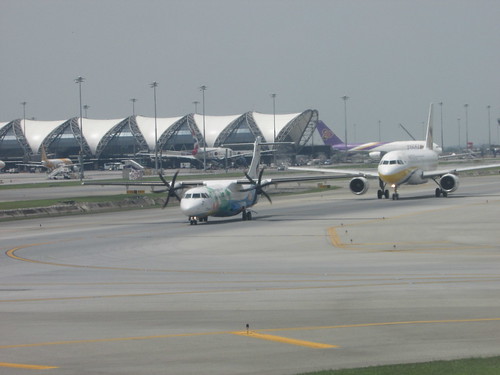
Yangon to Kathmandu via Bangkok, 11th May 2018: The queue of aircraft waiting for take-off extended behind my aircraft.
I enjoyed a very decent lunch on the flight. I was surprised that there was no multi-channel passenger entertainment system but a copy of the ‘Bangkok Post’ kept me engrossed for most of the journey.
Of course, our route to Nepal took us back over Myanmar and, eventually, over the mountainous terrain approaching Kathmandu. I had not expected such a large, sprawling conurbation of modern buildings. Even individual dwellings seemed to rise to five stories to make most use of the site area but there were also large blocks of apartments which would not have looked out of place in Europe.

Nepal from above: Arriving in Kathmandu 11th May 2018
I found the ‘Visa on Arrival’ system confusing and eventually managed to apply using a touch-screen machine similar to an automated airport Check-in terminal but including a camera to take a passport-style image of the applicant. This machine issued a receipt confirming my application which I then presented at a payment counter with 25 U.S. Dollars. Armed with a receipt for the application, the cash receipt and my passport, I then went to the row of immigration desks marked 'Foreigners' and was officially admitted to Nepal. Of course, each of these stages involved separate queues. By the time I reached the crowded Baggage Hall, my two bags were on the belt so I was able to quickly move through the Green Channel in customs and into an Arrival Hall lined with tourist information and taxi offices. There was no sign of representatives from tour companies and I found myself on the pavement outside with cars and taxis streaming by. Seeing my bewilderment, a policeman asked, in excellent English, if he could help and he pointed out a row of representatives behind a barrier on the other side of the road. I spotted the representative from ‘&Beyond’ and, having met up, we made out way to the car park and a people carrier. He explained that security in Kathmandu was unusually tight because the Prime Minister of India, Mr. Modi, was about to arrive on a diplomatic visit to Nepal.
The main roads bristled with police security and traffic was heavy. The flags of India and Nepal were frequently displayed and we passed a couple of temporary arches of welcome. Off the main roads, shops lined both sides of the narrow streets, frequently unsurfaced, with traffic and pedestrians crammed together. The effect was a bit like Yangon, a bit like Delhi but, I suspect, essentially Nepali.
We were headed for Dwarika’s Hotel but, my guide explained, Mr. Modi was hosting a dinner at Dwarika’s in the evening (although staying at the larger Hyatt Hotel) and that we would not be able to use the front entrance. Instead, we stopped in a very narrow lane and walked up an unpromising-looking alley to a set of padlocked gates. We were admitted by a uniformed security guard, who gave me a smart salute, and ushered to an outdoor reception desk. A member of the hotel staff gave me a brief tour of the layout of the hotel whilst waiting for a ‘thumbs up’ from a colleague to indicate that my room was ready.
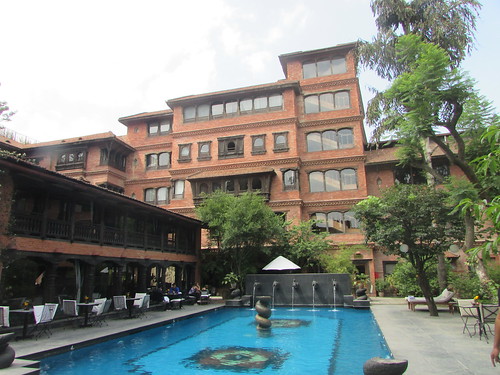
Dwarika's Hotel, Kathmandu, 11th May 2018
I was shown up to my spacious and charming room and, after a short interlude allowing a quick wash, I met my guide at the unlikely back entrance and we went on an absorbing sightseeing tour. First, we went to historic Patan Darbar Square where a number of important buildings and temples are being reconstructed, with international assistance, following the devastating 2015 earthquakes.
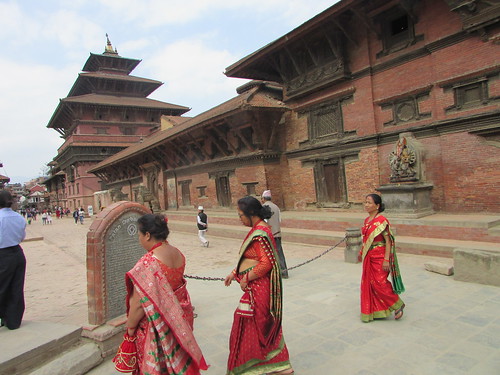 Patan, Kathmandu 11th May 2018
Patan, Kathmandu 11th May 2018
In the height of the afternoon rush hour, we made very tedious progress across the city to the Swayambhu Mahachaitva, the iconic hilltop Buddhist shrine. Although Nepal is only about 11% Buddhist and 80% Hindu, this shrine, dubbed the ‘Monkey Temple’ by ‘60s hippies who ‘discovered’ Nepal, is important to both Buddhist and Hindu. There were certainly crowds of visitors during my visit.
Another slow journey, giving further opportunities to study street life in Kathmandu, returned me to Dwarika’s (via the back gate) and my guide said he’d pick me up at 4.30 a.m. the following day. I didn’t venture out again that evening, very comfortable in my room. There was a very adequate Wi-Fi so I worked for a time and then slept very well in the large bed.
Related posts on this website
This is the first in a series of posts describing my visit to Nepal in 2018. Clicking on the 'Next report' link displays the post describing the next events. In this way, you may read about the trip in sequence.
Next report
Alternately, clicking on the 'All my Nepal reports' link displays all the posts on this trip in reverse date-of-posting order.
All my Nepal reports.
My pictures
Yangon to Kathmandu via Bangkok
Nepal from above
Kathmandu Airport
Patan, Kathmandu
Swayambhu Mahachitva Temple, Kathmandu
Kathmandu
Dwarika's Hotel, Kathmandu
All my pictures on this trip to Nepal can be found in the collection Nepal.
[Pictures linked 2-Jul-2018: Pictures added 7-Aug-2018]
Early Friday morning, I’d been booked to leave Yangon on the Bangkok Airways flight PG706 to Bangkok leaving at 5.50 a.m. Eddie Teh kindly suggested that I stay at the Belmond Governor's Residence on Thursday, allowing me to upload some pictures to the internet. This had the advantage that, rather than worry about my departure, Doctor Hla Tun could concentrate on his own flight Friday morning to Bagan, where he would no doubt face another gruelling weekend of consultations at Bagan Medical Clinic.
It was recommended to report to the airport at least two hours before departure for international flights so the hotel car dropped me at the airport about a quarter to four in the morming. There were a few travellers waiting outside the terminal building being held at bay by a rather aggressive young lady with a machine gun. Staff were arriving through the one entrance which was open but passengers were not allowed inside until 4.00 a.m., when I was the first person to enter and pass through a very friendly security check (ticket and passport checked, luggage X-rayed, passengers first through a detector arch then a cursory ‘frisk’ with a ‘wand’). I quickly found the Bangkok Airways check-in counters but it didn’t do me much good – they were all unstaffed. I chose to sit down and wait with my luggage nearby but younger, later arrivals formed a queue at the check-in counter. Eventually, staff arrived and spent some time meticulously preparing for the day’s work and two girls logged on to their booking system. One man appeared with a large plastic storage box from which he unloaded all the various notices to passengers which sit on top of the counters and, a nice touch, a potted plant for each of the three counters. Two of the three desks were staffed and they started check in. This process soon slowed as one of the computer screens stopped working. Just before my turn came, they managed to coax the failed screen back into life. After this frustrating start, the actual flight to Bangkok was uneventful, if noisy, as there was a party of about twenty Thai ladies on board who kept up loud chatter and laughter throughout the journey.
Bangkok Airport is huge. After we landed, it took us over ten minutes to taxi to the stand, then at least as long for the transfer bus to ferry us to the terminal. Then, I had to find the Transfer Desk and get my boarding pass for my onwards journey. The signs said that there were two transfer desks, one East, one West and each a few hundred yards away from me. I couldn’t work out which was appropriate to my flight, so I guessed (a 50-50 shot) and was lucky. A lot of walking and moving pavements took me to a very thorough Transit security check (all items in blue plastic trays for X-ray, shoes in red plastic tray for X-ray, whole body scan cubicle, cursory body search) which, combined with rather officious security staff, always spoils my mood. At least I was near the correct Transit Desk, obtained my boarding pass for the onwards journey to Kathmandu, Nepal, and took refuge in the nearby Thai lounge for a few minutes.
I only had a short walk from the lounge to the departure gate, too, and a transfer bus took us to a remote stand and our waiting aircraft. Matters quickly improved as the cabin service was excellent. It was a busy time at the airport with a stream of aircraft waiting to use the departure runway and it took at least 30 minutes of queuing and taxiing on the ground before our aircraft took off.

Yangon to Kathmandu via Bangkok, 11th May 2018: The queue of aircraft waiting for take-off extended behind my aircraft.
I enjoyed a very decent lunch on the flight. I was surprised that there was no multi-channel passenger entertainment system but a copy of the ‘Bangkok Post’ kept me engrossed for most of the journey.
Of course, our route to Nepal took us back over Myanmar and, eventually, over the mountainous terrain approaching Kathmandu. I had not expected such a large, sprawling conurbation of modern buildings. Even individual dwellings seemed to rise to five stories to make most use of the site area but there were also large blocks of apartments which would not have looked out of place in Europe.

Nepal from above: Arriving in Kathmandu 11th May 2018
I found the ‘Visa on Arrival’ system confusing and eventually managed to apply using a touch-screen machine similar to an automated airport Check-in terminal but including a camera to take a passport-style image of the applicant. This machine issued a receipt confirming my application which I then presented at a payment counter with 25 U.S. Dollars. Armed with a receipt for the application, the cash receipt and my passport, I then went to the row of immigration desks marked 'Foreigners' and was officially admitted to Nepal. Of course, each of these stages involved separate queues. By the time I reached the crowded Baggage Hall, my two bags were on the belt so I was able to quickly move through the Green Channel in customs and into an Arrival Hall lined with tourist information and taxi offices. There was no sign of representatives from tour companies and I found myself on the pavement outside with cars and taxis streaming by. Seeing my bewilderment, a policeman asked, in excellent English, if he could help and he pointed out a row of representatives behind a barrier on the other side of the road. I spotted the representative from ‘&Beyond’ and, having met up, we made out way to the car park and a people carrier. He explained that security in Kathmandu was unusually tight because the Prime Minister of India, Mr. Modi, was about to arrive on a diplomatic visit to Nepal.
The main roads bristled with police security and traffic was heavy. The flags of India and Nepal were frequently displayed and we passed a couple of temporary arches of welcome. Off the main roads, shops lined both sides of the narrow streets, frequently unsurfaced, with traffic and pedestrians crammed together. The effect was a bit like Yangon, a bit like Delhi but, I suspect, essentially Nepali.
We were headed for Dwarika’s Hotel but, my guide explained, Mr. Modi was hosting a dinner at Dwarika’s in the evening (although staying at the larger Hyatt Hotel) and that we would not be able to use the front entrance. Instead, we stopped in a very narrow lane and walked up an unpromising-looking alley to a set of padlocked gates. We were admitted by a uniformed security guard, who gave me a smart salute, and ushered to an outdoor reception desk. A member of the hotel staff gave me a brief tour of the layout of the hotel whilst waiting for a ‘thumbs up’ from a colleague to indicate that my room was ready.

Dwarika's Hotel, Kathmandu, 11th May 2018
I was shown up to my spacious and charming room and, after a short interlude allowing a quick wash, I met my guide at the unlikely back entrance and we went on an absorbing sightseeing tour. First, we went to historic Patan Darbar Square where a number of important buildings and temples are being reconstructed, with international assistance, following the devastating 2015 earthquakes.
 Patan, Kathmandu 11th May 2018
Patan, Kathmandu 11th May 2018
In the height of the afternoon rush hour, we made very tedious progress across the city to the Swayambhu Mahachaitva, the iconic hilltop Buddhist shrine. Although Nepal is only about 11% Buddhist and 80% Hindu, this shrine, dubbed the ‘Monkey Temple’ by ‘60s hippies who ‘discovered’ Nepal, is important to both Buddhist and Hindu. There were certainly crowds of visitors during my visit.
Another slow journey, giving further opportunities to study street life in Kathmandu, returned me to Dwarika’s (via the back gate) and my guide said he’d pick me up at 4.30 a.m. the following day. I didn’t venture out again that evening, very comfortable in my room. There was a very adequate Wi-Fi so I worked for a time and then slept very well in the large bed.
Related posts on this website
This is the first in a series of posts describing my visit to Nepal in 2018. Clicking on the 'Next report' link displays the post describing the next events. In this way, you may read about the trip in sequence.
Next report
Alternately, clicking on the 'All my Nepal reports' link displays all the posts on this trip in reverse date-of-posting order.
All my Nepal reports.
My pictures
Yangon to Kathmandu via Bangkok
Nepal from above
Kathmandu Airport
Patan, Kathmandu
Swayambhu Mahachitva Temple, Kathmandu
Kathmandu
Dwarika's Hotel, Kathmandu
All my pictures on this trip to Nepal can be found in the collection Nepal.
[Pictures linked 2-Jul-2018: Pictures added 7-Aug-2018]
Thursday 10 May 2018
Last day in Yangon
Thursday, 10th May 2018
This was my last day in Yangon. I had breakfast, finished packing and said farewell to everybody in Doctor Hla Tun's household. I was sad to be leaving. The Doctor ran me to the Belmond Governor's Residence hotel for a meeting with Eddie Teh, Belmond's General Manager in Myanmar, about the activities of the Belmond Myanmar Foundation in Myanmar.
Early Friday morning I was booked to fly to Bangkok on flight PG706 at the rather inconvenient time of 05:50, requiring a check-in at 03:50. Eddie kindly suggested that I stay at the Belmond Governor's Residence in the meantime, allowing me to upload some pictures to the internet. This has the advantage that, rather than worry about my departure, Doctor Hla Tun could concentrate on his own flight Friday morning to Bagan, where he would no doubt face another gruelling weekend of consultations at Bagan Medical Clinic.

Belmond Governor's Residence.
Related posts on this website
This is one of a series of posts describing my 13th visit to Myanmar. The post Travelling again is the first post in the series and then, by clicking on the 'Next report' links you may read about the trip in sequence.
Alternately, clicking on the 'All my Burma-2018 reports' link displays all the posts on this trip in reverse date-of-posting order.
All my Burma-2018 reports.
This is the last report on my Myanmar trip but from Bangkok, I flew to Kathmandu for a few days in Nepal. The first report on the Nepal trip is here.
Alternately, clicking on the 'All my Nepal reports' link displays all the posts on this trip in reverse date-of-posting order.
All my Nepal reports.
My pictures
The Governor's Residence Hotel, Yangon
All my general pictures on this amazing trip to Myanmar can be found in the collection Burma 2018.
['My pictures' links and picture added 7-Aug-2018]
This was my last day in Yangon. I had breakfast, finished packing and said farewell to everybody in Doctor Hla Tun's household. I was sad to be leaving. The Doctor ran me to the Belmond Governor's Residence hotel for a meeting with Eddie Teh, Belmond's General Manager in Myanmar, about the activities of the Belmond Myanmar Foundation in Myanmar.
Early Friday morning I was booked to fly to Bangkok on flight PG706 at the rather inconvenient time of 05:50, requiring a check-in at 03:50. Eddie kindly suggested that I stay at the Belmond Governor's Residence in the meantime, allowing me to upload some pictures to the internet. This has the advantage that, rather than worry about my departure, Doctor Hla Tun could concentrate on his own flight Friday morning to Bagan, where he would no doubt face another gruelling weekend of consultations at Bagan Medical Clinic.

Belmond Governor's Residence.
Related posts on this website
This is one of a series of posts describing my 13th visit to Myanmar. The post Travelling again is the first post in the series and then, by clicking on the 'Next report' links you may read about the trip in sequence.
Alternately, clicking on the 'All my Burma-2018 reports' link displays all the posts on this trip in reverse date-of-posting order.
All my Burma-2018 reports.
This is the last report on my Myanmar trip but from Bangkok, I flew to Kathmandu for a few days in Nepal. The first report on the Nepal trip is here.
Alternately, clicking on the 'All my Nepal reports' link displays all the posts on this trip in reverse date-of-posting order.
All my Nepal reports.
My pictures
The Governor's Residence Hotel, Yangon
All my general pictures on this amazing trip to Myanmar can be found in the collection Burma 2018.
['My pictures' links and picture added 7-Aug-2018]
A trip to Bago
Wednesday, 9th May 2018
The Doctor had made arrangements for an official visit to Bago station and he drove me there and accompanied me on tour. We left at about 11.20 a.m. and spent the next 45 minutes struggling through Yangon's horrendous traffic. Once clear of the worst of the traffic, we made better time on the road to Bago, a dual carriageway with three lanes in each direction. There wasn't much proper countryside visible - 'strip' development continued to Bago.
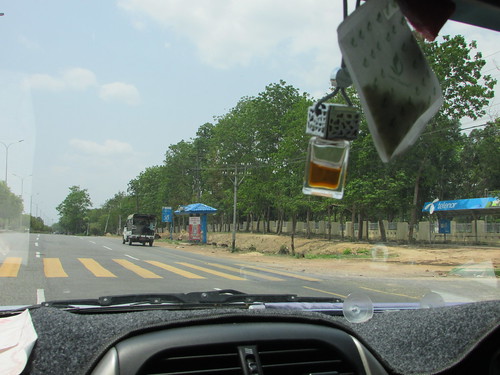
The road from Yangon to Bago, near Bago, 9th May 2018.
The Doctor and I arrived at Bago station at 1.00 p.m. and were ushered into the Station Master's spacious meeting room.
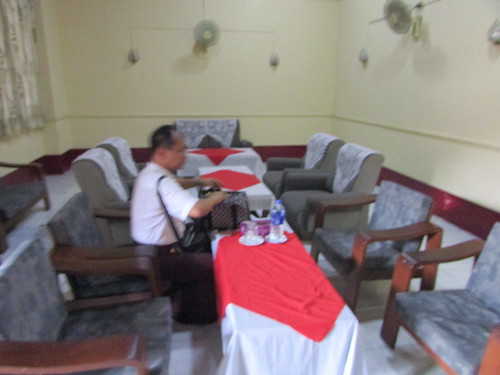
The Railway at Bago, 9th May 2018: The Station Master's spacious meeting room.
After introductions to the people who would accompany us on our tour, including an English speaker, we set off to check out the area. We started at the Station Master's Office, where one man directs all train movements in the area. Then we crossed various tracks to reach the North signal cabin. Our hosts were fascinated with my attention to detail, as I delightedly photographed trackside equipment from a former era.
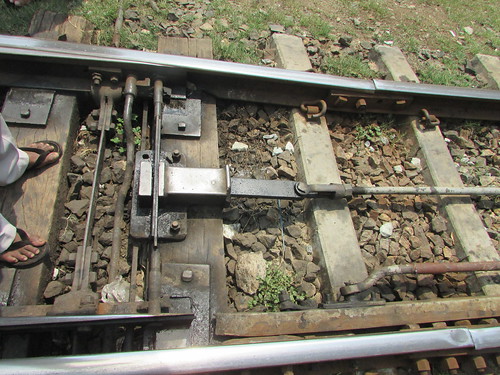
The Railway at Bago, 9th May 2018: Facing point lock and Locking Bar.
We entered the mechanical signal cabin of Bago North where, on the operating floor, two signalmen were on duty. I photographed everything in sight for later study and the young signalman set up a route to demonstrate the operation of the levers (but I didn't ask to try myself).

The Railway at Bago, 9th May 2018: The young signalman set up a route.
I asked to see the locking room and, again, took a number of photographs.
To my delight, they offered to show me to locomotive shed, where I knew they kept three steam locomotives sometimes used by the German travel firm FarRail Tours (www.farrail.com) for photographic charters. Their Trip Reports are full of interesting information and pictures. I climbed onto the footplate of each locomotive in turn, grabbing as many pictures as I could.
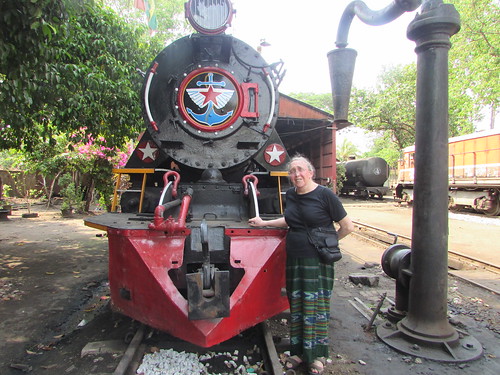
The Railway at Bago, 9th May 2018: For once, Jan looks quite happy.
With temperatures in the high 30s Celsius, I was fairly tired when I'd finished but still disappointed when they said there wasn't time to visit Bago South signal cabin.
This was because it had been suggested that I might like to return to Yangon by train, a suggestion I readily accepted. Train 32 from Naypyitaw (from where it departed at 08:00) was due to arrive, they said, at 15:00. They also suggested that my photographic opportunities might be better in an Ordinary Class coach, where all the windows were sure to be fully open, rather than an Upper Class coach. I agreed with their reasoning and a ticket was issued. Then they said the train was 15 minutes late and it actually arrived about 15:20.
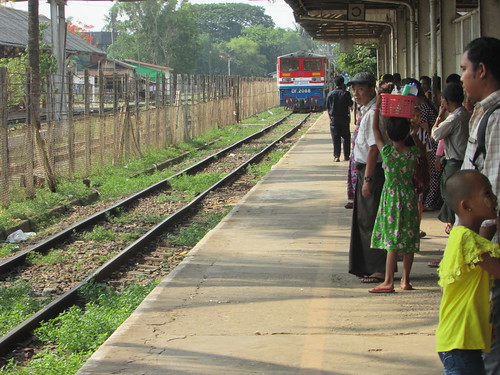
The Railway at Bago, 9th May 2018: Train 32 from Naypyitaw arriving at Bago.
According to the rail travel website 'The Man in Seat 61' here, the train was not due in until 15:20 and was due to depart at 15:23, arriving Yangon at 17:00. Well, we left about 15:23 and cracked along at what, for a Burmese train, was a a very good speed. We made just one stop and arrived at Yangon Central Station at 17:00.
The Doctor made the journey back in his car and met me at Yangon Central Station. Then we picked up the Doctor's wife and daughter and drove back to the Doctor's home.
I’ll defer the technical railway stuff to a later post.
Related posts on this website
This is one of a series of posts describing my 13th visit to Myanmar.
The post Travelling again is the first post in the series.
Clicking on the 'Next report' link will show the post describing the next events. In this way, you may read about the trip in sequence.
Next report
Alternately, clicking on the 'All my Burma-2018 reports' link displays all the posts on this trip in reverse date-of-posting order.
All my Burma-2018 reports.
My pictures
Where necessary, clicking on an image above will display an 'uncropped' view or, alternately, pictures may be selected, viewed or downloaded, in various sizes, from the albums below:-
Yangon around and about.
Bago Station (earlier pictures).
The Railway at Bago, 9th May 2018.
Bago to Yangon by Train, 9th May 2018.
All my general pictures on this trip to Myanmar can be found at Burma 2018.
['My pictures' links and pictures added 6-Aug-2018]
The Doctor had made arrangements for an official visit to Bago station and he drove me there and accompanied me on tour. We left at about 11.20 a.m. and spent the next 45 minutes struggling through Yangon's horrendous traffic. Once clear of the worst of the traffic, we made better time on the road to Bago, a dual carriageway with three lanes in each direction. There wasn't much proper countryside visible - 'strip' development continued to Bago.

The road from Yangon to Bago, near Bago, 9th May 2018.
The Doctor and I arrived at Bago station at 1.00 p.m. and were ushered into the Station Master's spacious meeting room.

The Railway at Bago, 9th May 2018: The Station Master's spacious meeting room.
After introductions to the people who would accompany us on our tour, including an English speaker, we set off to check out the area. We started at the Station Master's Office, where one man directs all train movements in the area. Then we crossed various tracks to reach the North signal cabin. Our hosts were fascinated with my attention to detail, as I delightedly photographed trackside equipment from a former era.

The Railway at Bago, 9th May 2018: Facing point lock and Locking Bar.
We entered the mechanical signal cabin of Bago North where, on the operating floor, two signalmen were on duty. I photographed everything in sight for later study and the young signalman set up a route to demonstrate the operation of the levers (but I didn't ask to try myself).

The Railway at Bago, 9th May 2018: The young signalman set up a route.
I asked to see the locking room and, again, took a number of photographs.
To my delight, they offered to show me to locomotive shed, where I knew they kept three steam locomotives sometimes used by the German travel firm FarRail Tours (www.farrail.com) for photographic charters. Their Trip Reports are full of interesting information and pictures. I climbed onto the footplate of each locomotive in turn, grabbing as many pictures as I could.

The Railway at Bago, 9th May 2018: For once, Jan looks quite happy.
With temperatures in the high 30s Celsius, I was fairly tired when I'd finished but still disappointed when they said there wasn't time to visit Bago South signal cabin.
This was because it had been suggested that I might like to return to Yangon by train, a suggestion I readily accepted. Train 32 from Naypyitaw (from where it departed at 08:00) was due to arrive, they said, at 15:00. They also suggested that my photographic opportunities might be better in an Ordinary Class coach, where all the windows were sure to be fully open, rather than an Upper Class coach. I agreed with their reasoning and a ticket was issued. Then they said the train was 15 minutes late and it actually arrived about 15:20.

The Railway at Bago, 9th May 2018: Train 32 from Naypyitaw arriving at Bago.
According to the rail travel website 'The Man in Seat 61' here, the train was not due in until 15:20 and was due to depart at 15:23, arriving Yangon at 17:00. Well, we left about 15:23 and cracked along at what, for a Burmese train, was a a very good speed. We made just one stop and arrived at Yangon Central Station at 17:00.
The Doctor made the journey back in his car and met me at Yangon Central Station. Then we picked up the Doctor's wife and daughter and drove back to the Doctor's home.
I’ll defer the technical railway stuff to a later post.
Related posts on this website
This is one of a series of posts describing my 13th visit to Myanmar.
The post Travelling again is the first post in the series.
Clicking on the 'Next report' link will show the post describing the next events. In this way, you may read about the trip in sequence.
Next report
Alternately, clicking on the 'All my Burma-2018 reports' link displays all the posts on this trip in reverse date-of-posting order.
All my Burma-2018 reports.
My pictures
Where necessary, clicking on an image above will display an 'uncropped' view or, alternately, pictures may be selected, viewed or downloaded, in various sizes, from the albums below:-
Yangon around and about.
Bago Station (earlier pictures).
The Railway at Bago, 9th May 2018.
Bago to Yangon by Train, 9th May 2018.
All my general pictures on this trip to Myanmar can be found at Burma 2018.
['My pictures' links and pictures added 6-Aug-2018]
Tuesday 8 May 2018
Resting again
Tuesday, 8th May 2018
Last night, the Doctor and I returned to his Yangon home for the first time since leaving on Friday 27th April. In that time, the Doctor has carried out two full weekends of consultations at Bagan Medical Clinic and, in between those weekends, we made a fascinating side trip to Chin State led by the Monk from the Clinic and accompanied by the Doctor's wife. After the second weekend at the Clinic, we made food donations at two Orphanages in Pyin Oo Lwin and made a journey by train over the famous Gokteik Viaduct before flying back to Yangon from Mandalay.
I slept very well on Monday night and was told that Tuesday was to be a rest day for me. After breakfast, I settled down in my room to work on the internet, dealing with e-mails and updating this blog.
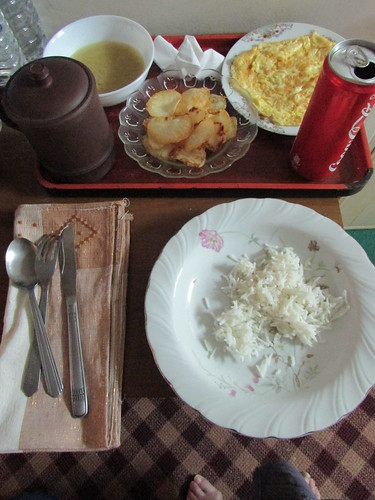
A splendid meal, tailored to my rather conservative tastes, at the Doctor's house in Yangon.
I've enjoyed many great experiences visiting different parts of the world (for more details, see the post Jan Ford's Travels) but I think that this trip has surpassed any previous travelling I've done. The emotion of being immersed in all this activity is almost overwhelming. I've met some lovely, welcoming people.
Tomorrow, the Doctor and I go on a railway visit (surprise, surprise) then on Thursday I've a meeting with Eddie Teh, Belmond's General Manager in Myanmar.
Then, my extraordinary trip to Myanmar will be over and early Friday morning I'm booked to fly out of Yangon's Mingalardon airport.
Related posts on this website
This is one of a series of posts describing my 13th visit to Myanmar. The post Travelling again is the first post in the series.
Clicking on the 'Next report' link displays the post describing the next events. In this way, you may read about the trip in sequence.
Next report
Alternately, clicking on the 'All my Burma-2018 reports' link displays all the posts on this trip in reverse date-of-posting order.
All my Burma-2018 reports
My pictures
Where necessary, clicking on the image above will display an 'uncropped' view or, alternately, pictures may be selected, viewed or downloaded, in various sizes, from the albums below:-
Yangon around and about.
All my pictures on this trip to Myanmar can be found at Burma 2018.
['My pictures' links and picture added 6-Aug-2018]
Last night, the Doctor and I returned to his Yangon home for the first time since leaving on Friday 27th April. In that time, the Doctor has carried out two full weekends of consultations at Bagan Medical Clinic and, in between those weekends, we made a fascinating side trip to Chin State led by the Monk from the Clinic and accompanied by the Doctor's wife. After the second weekend at the Clinic, we made food donations at two Orphanages in Pyin Oo Lwin and made a journey by train over the famous Gokteik Viaduct before flying back to Yangon from Mandalay.
I slept very well on Monday night and was told that Tuesday was to be a rest day for me. After breakfast, I settled down in my room to work on the internet, dealing with e-mails and updating this blog.

A splendid meal, tailored to my rather conservative tastes, at the Doctor's house in Yangon.
I've enjoyed many great experiences visiting different parts of the world (for more details, see the post Jan Ford's Travels) but I think that this trip has surpassed any previous travelling I've done. The emotion of being immersed in all this activity is almost overwhelming. I've met some lovely, welcoming people.
Tomorrow, the Doctor and I go on a railway visit (surprise, surprise) then on Thursday I've a meeting with Eddie Teh, Belmond's General Manager in Myanmar.
Then, my extraordinary trip to Myanmar will be over and early Friday morning I'm booked to fly out of Yangon's Mingalardon airport.
Related posts on this website
This is one of a series of posts describing my 13th visit to Myanmar. The post Travelling again is the first post in the series.
Clicking on the 'Next report' link displays the post describing the next events. In this way, you may read about the trip in sequence.
Next report
Alternately, clicking on the 'All my Burma-2018 reports' link displays all the posts on this trip in reverse date-of-posting order.
All my Burma-2018 reports
My pictures
Where necessary, clicking on the image above will display an 'uncropped' view or, alternately, pictures may be selected, viewed or downloaded, in various sizes, from the albums below:-
Yangon around and about.
All my pictures on this trip to Myanmar can be found at Burma 2018.
['My pictures' links and picture added 6-Aug-2018]
Gokteik Viaduct Notes
This post adds some technical comments to the post Gokteik Viaduct
We arrived at Pyin Oo Lwin station a little before 08:00 and went to the booking office for our pre-arranged tickets from Pyin Oo Lwin to Nawngpeng. Handwritten tickets for Upper Class with seat reservations were prepared with due ceremony and my passport number was included in the ticket information.
In the booking hall there was a black notice board with details of the two departures and with that day's notes added in chalk in English. Our train number 131 was shown as an Up train. In the past, it took me a while to realise that UP and DOWN on the Mandalay-Yangon line refer to trains to and from Mandalay, respectively. Thus, I'd expected the train we were about to board to be a Down train but, apparently, it's not so.
To help passengers find their correct coach, at principal stations there is an Arrivals and Departures board showing the make-up of passenger trains. Each coach is represented by a disc with vehicle details inscribed. The appropriate discs are hung on a horizontal series of small hooks so that the composition of each train is readily visible.
The discs representing our train number 131, left to right, were marked Guard, Parcels, Upper 2, Ordinary 3, Ordinary 2, Upper 1, Ordinary 1, Locomotive.
Train number 132 was similarly represented.
Our train number 131 was already in the platform with Bo-Bo-Bo DF.2080 in red and blue livery (built in China by Dalian Locomotive and Rolling Stock) on the front of 3 air braked carriages (2 Ordinary Class and 1 Upper Class) with a bogie parcels van (type GBHV) and a bogie Guard's/Parcels van (type VBHV) on the rear. The locomotive and all vehicles were air braked and fitted with automatic couplers. The Doctor said his friend had told him that the load limit from Mandalay to Pyin Oo Lwin is 180 tons but that, beyond Pyin Oo Lwin, the limit is increased to 240 tons.
Another Bo-Bo-Bo, DF.1629 in brown and cream livery, was propelling two flat cars used as shunters' wagons towards the rear of our train, number 131.The flat cars were modern, air braked with a wheel to operate a handbrake. Both cars had locating dowels at each corner for carrying a standard shipping container. The one flat car, R.9.2021 had two additional dowels perhaps for carrying half-length containers and the maker's plate 'TITAGARH WAGONS LIMITED 2013'. The Titagarh Group (website here) is a heavy engineering company based in India but now developing an export market.
It was clear that DF.1629 was going to remove the two goods wagons from the rear of train number 131, with a view to strengthening the passenger accommodation. But it took three attempts before the coupling between the leading shunters' wagon and the rear coach mated correctly.
Whilst the additional coaches were being fetched, we'd visited the Stationmaster's Office so that I could photograph the track diagram. The 'wye' at the bottom of the diagram serves the loco shed which I understand is still in use.
Approaching a Block Station like Pyin Oo Win in either direction, the first indication a driver receives is a white, rectangular warning board, set half a mile before the distant signal. All distant signals are fixed and come in a wide variety of designs. Next comes the 'Outer' or 'Home' stop signal. This is operated by the pointsman at the entrance to the station where a green flag indicates that the points have been set and clipped for the train to enter the station. Before leaving the station, the driver must be in possession of a paper Line Clear form for the Block Section ahead and must have a green flag from the pointsman to indicates that the points have been set and clipped for the train to leave the station. Finally, the train passes a 'Limit of Shunt' board. This is a white square with a smaller red square in the middle.
The station is not interlocked in the sense of having a lever frame but four Trapped Key Locking Boxes were mounted on the wall near the door. The Locking Boxes for roads 3, 4 and 5 had their keys but the unmarked box had no key, presumably because of the shunt in progress. I took pictures of the Stationmaster on the radio, the book of paper Line Clear forms authorising train movements and the Train Register book.
For more information on the control of trains in Myanmar, see the post here and for information about the control of points and interlocking see the post here. Alternately, there's an index of all my Myanma Railways posts (which may not always be up-to-date) here.
Back on the platform I watched DF.1629 propelling two Upper Class carriages and the two goods wagons onto the train and, to my surprise, the re-inforced train departed at 08:22 as scheduled.
The ruling gradient appeared to be downhill and we we travelling faster that I previously recalled. We came to a brief stand at the approach to a station and, once the points were set away from a sand drag, the upper quadrant signal cleared and we entered the platform. We carried on, making brief intermediate stops, to Hsam Ma Hse. This had the normal passing loop plus a third line on which DF.2063 (red and blue livery) waited with a ballast train, adjacent to a yard with numerous large piles of ballast. There was a belt-type elevator which apparently was used to load the ballast wagons.
Our next stop was at Nawnghkio, a more important station, where we stood for a few minutes loading and unloading freight.
Five or six kilometres beyond Nawnghkio, we started getting views of the famous viaduct. What struck me was how much higher than the bridge we were and I wondered how we'd lose height. Well, we did it by twisting and turning down the mountain side, around tight curves and descending through rock cuttings. Finally, we headed away at right angles with the bridge on our right. Below us, there was a parallel line at lower level with the semaphore Outer signal for Gokteik. We traversed the expected 'dumbell' loop now heading back towards the bridge now on our left and stopped at the small isolated station of Gokteik. The line curved left to lead us onto the viaduct which we traversed slowly (there's a 5 m.p.h. limit displayed). This monumental structure, set in impenetrable jungle, gives feelings of awe that are hard to convey.
at the entry to the station where hand operated Immediately after the viaduct, there are two tunnels. The second was certainly brick-lined, I'm not sure about the first. The locomotive was now working hard as we climbed away from the bridge, so I was not surprised when we passed a sand drag (trailing to us) protected by stop signals. Soon, we arrived in Nawngpeng, where we disembarked. I made it a 'right time' arrival. However, the train did not, as suggested by the travel website ‘The Man in Seat 61’ here wait for train 132 to arrive and leave at 12:25 but set off for Lashio a few minutes after noon.
Station distances from Wikipedia
Pyin U Lwin 422 1/2
Pwe Kaul 427 3/4
Wet Wun 433 1/2
Sin Lan Su 438 1/4
Hsam Ma Hse 444
Nawnghkio 456
Gokteik 463 Gokteik Viaduct
Nawngpeng 472 1/4
The complete list is here.
Information from 'The Man in Seat 61'
There is one passenger train daily each way over the Gokteik Viaduct. Upper and Ordinary Class seats are provided.
Mandalay to Pyin Oo Lwin is 67 km (42 miles).
Mandalay to Hsipaw is 206km (129 miles).
Mandalay to Lashio is 280 km (175 miles).
Train number 131: Mandalay > Pyin Oo Lwin > Lashio
Train number 132: Lashio > Pyin Oo Lwin > Mandalay
For all the information on train travel in Burma on this website, click here.
My pictures
Where necessary, clicking on an image above will display an 'uncropped' view or, alternately, pictures from may be selected, viewed or downloaded, in various sizes, from the albums below:-
By train over Gokteik Viaduct 7th May 2018.
All my pictures on this trip to Myanmar can be found at Burma 2018.
['My pictures' link added 4-Aug-2018]
We arrived at Pyin Oo Lwin station a little before 08:00 and went to the booking office for our pre-arranged tickets from Pyin Oo Lwin to Nawngpeng. Handwritten tickets for Upper Class with seat reservations were prepared with due ceremony and my passport number was included in the ticket information.
In the booking hall there was a black notice board with details of the two departures and with that day's notes added in chalk in English. Our train number 131 was shown as an Up train. In the past, it took me a while to realise that UP and DOWN on the Mandalay-Yangon line refer to trains to and from Mandalay, respectively. Thus, I'd expected the train we were about to board to be a Down train but, apparently, it's not so.
To help passengers find their correct coach, at principal stations there is an Arrivals and Departures board showing the make-up of passenger trains. Each coach is represented by a disc with vehicle details inscribed. The appropriate discs are hung on a horizontal series of small hooks so that the composition of each train is readily visible.
The discs representing our train number 131, left to right, were marked Guard, Parcels, Upper 2, Ordinary 3, Ordinary 2, Upper 1, Ordinary 1, Locomotive.
Train number 132 was similarly represented.
Our train number 131 was already in the platform with Bo-Bo-Bo DF.2080 in red and blue livery (built in China by Dalian Locomotive and Rolling Stock) on the front of 3 air braked carriages (2 Ordinary Class and 1 Upper Class) with a bogie parcels van (type GBHV) and a bogie Guard's/Parcels van (type VBHV) on the rear. The locomotive and all vehicles were air braked and fitted with automatic couplers. The Doctor said his friend had told him that the load limit from Mandalay to Pyin Oo Lwin is 180 tons but that, beyond Pyin Oo Lwin, the limit is increased to 240 tons.
Another Bo-Bo-Bo, DF.1629 in brown and cream livery, was propelling two flat cars used as shunters' wagons towards the rear of our train, number 131.The flat cars were modern, air braked with a wheel to operate a handbrake. Both cars had locating dowels at each corner for carrying a standard shipping container. The one flat car, R.9.2021 had two additional dowels perhaps for carrying half-length containers and the maker's plate 'TITAGARH WAGONS LIMITED 2013'. The Titagarh Group (website here) is a heavy engineering company based in India but now developing an export market.
It was clear that DF.1629 was going to remove the two goods wagons from the rear of train number 131, with a view to strengthening the passenger accommodation. But it took three attempts before the coupling between the leading shunters' wagon and the rear coach mated correctly.
Whilst the additional coaches were being fetched, we'd visited the Stationmaster's Office so that I could photograph the track diagram. The 'wye' at the bottom of the diagram serves the loco shed which I understand is still in use.
Approaching a Block Station like Pyin Oo Win in either direction, the first indication a driver receives is a white, rectangular warning board, set half a mile before the distant signal. All distant signals are fixed and come in a wide variety of designs. Next comes the 'Outer' or 'Home' stop signal. This is operated by the pointsman at the entrance to the station where a green flag indicates that the points have been set and clipped for the train to enter the station. Before leaving the station, the driver must be in possession of a paper Line Clear form for the Block Section ahead and must have a green flag from the pointsman to indicates that the points have been set and clipped for the train to leave the station. Finally, the train passes a 'Limit of Shunt' board. This is a white square with a smaller red square in the middle.
The station is not interlocked in the sense of having a lever frame but four Trapped Key Locking Boxes were mounted on the wall near the door. The Locking Boxes for roads 3, 4 and 5 had their keys but the unmarked box had no key, presumably because of the shunt in progress. I took pictures of the Stationmaster on the radio, the book of paper Line Clear forms authorising train movements and the Train Register book.
For more information on the control of trains in Myanmar, see the post here and for information about the control of points and interlocking see the post here. Alternately, there's an index of all my Myanma Railways posts (which may not always be up-to-date) here.
Back on the platform I watched DF.1629 propelling two Upper Class carriages and the two goods wagons onto the train and, to my surprise, the re-inforced train departed at 08:22 as scheduled.
The ruling gradient appeared to be downhill and we we travelling faster that I previously recalled. We came to a brief stand at the approach to a station and, once the points were set away from a sand drag, the upper quadrant signal cleared and we entered the platform. We carried on, making brief intermediate stops, to Hsam Ma Hse. This had the normal passing loop plus a third line on which DF.2063 (red and blue livery) waited with a ballast train, adjacent to a yard with numerous large piles of ballast. There was a belt-type elevator which apparently was used to load the ballast wagons.
Our next stop was at Nawnghkio, a more important station, where we stood for a few minutes loading and unloading freight.
Five or six kilometres beyond Nawnghkio, we started getting views of the famous viaduct. What struck me was how much higher than the bridge we were and I wondered how we'd lose height. Well, we did it by twisting and turning down the mountain side, around tight curves and descending through rock cuttings. Finally, we headed away at right angles with the bridge on our right. Below us, there was a parallel line at lower level with the semaphore Outer signal for Gokteik. We traversed the expected 'dumbell' loop now heading back towards the bridge now on our left and stopped at the small isolated station of Gokteik. The line curved left to lead us onto the viaduct which we traversed slowly (there's a 5 m.p.h. limit displayed). This monumental structure, set in impenetrable jungle, gives feelings of awe that are hard to convey.
at the entry to the station where hand operated Immediately after the viaduct, there are two tunnels. The second was certainly brick-lined, I'm not sure about the first. The locomotive was now working hard as we climbed away from the bridge, so I was not surprised when we passed a sand drag (trailing to us) protected by stop signals. Soon, we arrived in Nawngpeng, where we disembarked. I made it a 'right time' arrival. However, the train did not, as suggested by the travel website ‘The Man in Seat 61’ here wait for train 132 to arrive and leave at 12:25 but set off for Lashio a few minutes after noon.
Station distances from Wikipedia
Pyin U Lwin 422 1/2
Pwe Kaul 427 3/4
Wet Wun 433 1/2
Sin Lan Su 438 1/4
Hsam Ma Hse 444
Nawnghkio 456
Gokteik 463 Gokteik Viaduct
Nawngpeng 472 1/4
The complete list is here.
Information from 'The Man in Seat 61'
There is one passenger train daily each way over the Gokteik Viaduct. Upper and Ordinary Class seats are provided.
Mandalay to Pyin Oo Lwin is 67 km (42 miles).
Mandalay to Hsipaw is 206km (129 miles).
Mandalay to Lashio is 280 km (175 miles).
Train number 131: Mandalay > Pyin Oo Lwin > Lashio
| Station | Arrive | Depart |
| Mandalay | 04:00 | |
| Pyin Oo Lwin (Maymyo) | 07:52 | 08:22 |
| Gokteik | 11:03 | 11:08 |
| Nawngpeng | 11:58 | 12:25 |
| Kyaukme | 13:19 | 13:39 |
| Hsipaw (Thibaw) | 14:55 | 15:15 |
| Lashio | 19:35 |
Train number 132: Lashio > Pyin Oo Lwin > Mandalay
| Station | Arrive | Depart |
| Lashio | 05:00 | |
| Hsipaw (Thibaw) | 09:25 | 09:40 |
| Kyaukme | 11:05 | 11:25 |
| Nawngpeng | 12:22 | 12:30 |
| Gokteik | 13:23 | 13:25 |
| Pyin Oo Lwin (Maymyo) | 16:05 | 17:40 |
| Mandalay | 22:40 |
For all the information on train travel in Burma on this website, click here.
My pictures
Where necessary, clicking on an image above will display an 'uncropped' view or, alternately, pictures from may be selected, viewed or downloaded, in various sizes, from the albums below:-
By train over Gokteik Viaduct 7th May 2018.
All my pictures on this trip to Myanmar can be found at Burma 2018.
['My pictures' link added 4-Aug-2018]
Gokteik Viaduct
Did I mention my interest in railways? All my posts on the railways of Myanmar can be found here. When I first told the Doctor that I wanted to travel on the train over the famous Goktiek Viaduct, he insisted on making arrangements for me. As things worked out, he was also able to accompany me on the train.
Monday, 7th May 2018
I took breakfast in the Dining Hall on the 5th floor of Hotel Maymyo then checked out ready to be picked up by the Doctor at 7.40 a.m. to catch the train from Pyin Oo Lwin station across the Gokteik Viaduct.
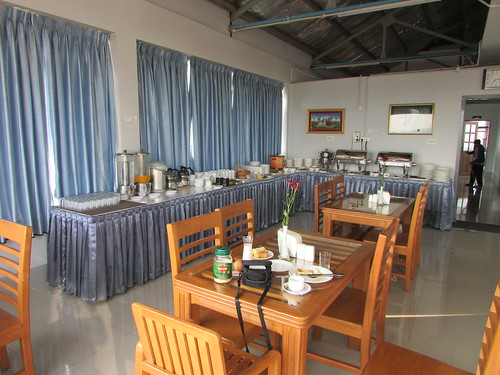
Breakfast at Hotel Maymyo, Pyin Oo Lwin, 7th May 2018
The Gokteik Viaduct, opened 1900, is a steel trestle bridge on the railway line from Mandalay to Lashio almost 700 metres long which carries a single track at a height of over 300 metres above the ground. There's a Wikipedia article here.
The height and length of the viaduct make it a ‘must see’ for many tourists and the travel website ‘The Man in Seat 61’ has more information here.
Train 131 from Mandalay to Lashio was scheduled to leave Pyin Oo Lwin at 08:22, pass over the Gokteik Viaduct and arrive at Nawngpeng at 11:58. It was arranged that our car would go ahead by road to Nawngpeng using the Oriental Highway, pick up the Doctor and the writer on arrival by train then drive us via Pyin Oo Lwin to Mandalay Airport. The Doctor had booked tickets for us to Yangon on separate flights to keep the cost down.
Well, all the arrangements worked well and the viaduct is certainly impressive. There were a number of European travellers on the train who also seemed to enjoy the experience and many photographs were taken. You’ll probably be relieved to learn that I’m deferring the technical railway stuff to a later post (but you can find it at Gokteik Viaduct Notes then use the 'back button' to return here).
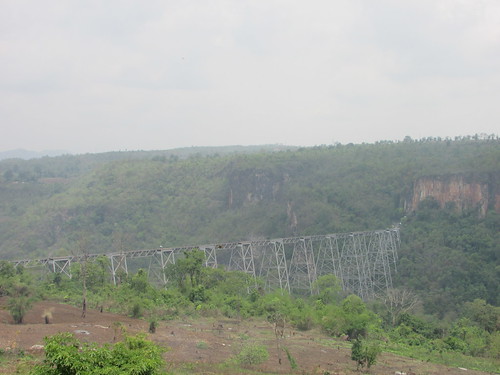
By train over Gokteik Viaduct 7th May 2018
The car collected us at Nawngpeng as planned and we set off on the Oriental Highway towards Pyin Oo Lwin. The amount of lorry traffic was astonishing, mainly 8-wheel fixed wheelbase and 10- and 12-wheel articulated rigs. Via a series of spectacular zig-zags, the road descended into the valley then, using a similar technique, climbed up the opposite side of the valley.
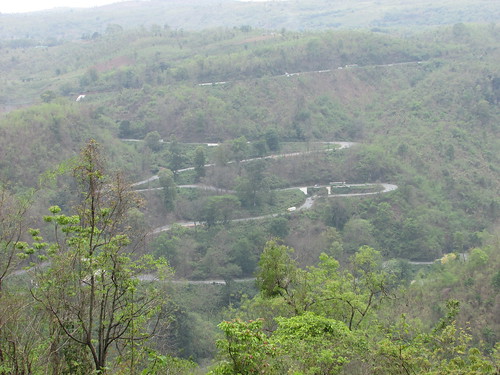
Nawngpeng - Mandalay Airport by road 7th May 2018: View of zig-zag road from opposite side of valley.
As I’ve previously reported, Myanmar drives on the right (despite the fact that many vehicles, like the Toyota Crown I was travelling in, have the driver on the right). However, the bigger lorries need space to turn so, even if they should be driving on the inside of a hairpin bend, they simply take the wrong side of the road so as to be on the outside of the hairpin. Drivers of smaller vehicles travelling in the opposite direction, with admirable pragmatism, simply also adopt the wrong side of the road until they’re clear of the offending lorries and so the traffic keeps moving (though it looks frightening).
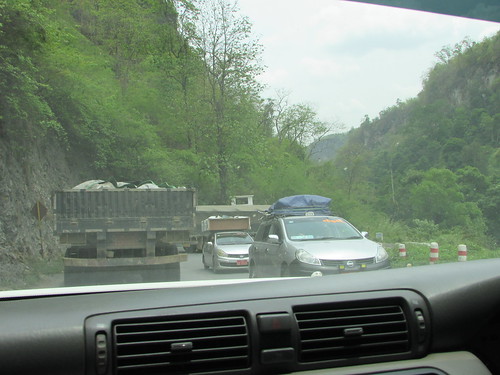
Nawngpeng - Mandalay Airport by road 7th May 2018: On the hairpins, traffic informally adopts the wrong side of the road to allow lorries space to turn.
Having reached a plateau, our route continued on easier gradients. We stopped at a large, obviously popular, tea-shop. The floor was littered with empty water bottles and debris from a busy morning but I was amazed when the place setting for each diner (plate, bowl, tea cup and cutlery) arrived packed in a plastic bag and looked clean. Fearing my foreigner’s delicate digestion, the Doctor often washes cups or cutlery again before letting me use them but on this occasion there was no need.
We carried on to Pyin Oo Lwin where the Doctor and I enjoyed a cup of heated milk (a sort of informal Pasteurisation) at a roadside shop.

The roadside shop in Pyin Oo Lwin where we drank heated milk.
As we left Pyin Oo Lwin, the Doctor made some purchases at a group of roadside stalls (Pyin Oo Lwin is famous for strawberries).
Although parts of the road descending to the plain were already dual-carriageway the last time I was on it, massive road improvement has occurred since. This construction project is ongoing - as we came nearer to Mandalay, the Oriental Highway became one vast construction site with traffic in both directions rushing across a dusty, unsealed surface with no markings or verges and poor visibility from the clouds of dust. The speeding vehicles were sharing the space with dozens of excavators, graders, road rollers and tipper lorries all oblivious to the traffic and operating within inches of the passing cars, pick-ups lorries and tankers. It was an amazing, anarchic scene. There were also a number of rather alien-looking tracked vehicles, each attached by an umbilical cord to a large, wheeled packaged unit. I assumed that they were pneumatic rock drills.

Road improvements in progress on the Oriental Highway.
At last, we returned to the relative discipline of a dual carriageway, paid at a couple of toll stations, passed through Myitnge and took the road to Mandalay Airport.
The Doctor had little time to catch his flight to Yangon and dashed off to check-in, encumbered with various shopping carriers of his purchases. I said farewell to our driver and the young lady from Belmond as they set off on the long drive back to Bagan. I then had a couple of hours before my own flight to Yangon. A little after 9.00 p.m., I arrived at Mingalardon Airport to find the Doctor and his wife waiting for me. We returned to the Doctor's house by taxi and, tired but thrilled by our various explorations, I slept well with the promise that the following day was a day of rest for me. For once, I was disinclined to argue.
Related posts on this website
This is one of a series of posts describing my 13th visit to Myanmar.
The post Travelling again is the first post in the series.
Clicking on the 'Next report' link will show the post describing the next events. In this way, you may read about the trip in sequence.
Next report
Alternately, clicking on the 'All my Burma-2018 reports' link displays all the posts on this trip in reverse date-of-posting order.
All my Burma-2018 reports
My pictures
Where necessary, clicking on an image above will display an 'uncropped' view or, alternately, pictures from may be selected, viewed or downloaded, in various sizes, from the albums below:-
Hotel Maymyo, Pyin Oo Lwin, 7th May 2018.
By train over Gokteik Viaduct 7th May 2018.
Nawngpeng - Mandalay Airport by road 7th May 2018.
All my pictures on this trip to Myanmar can be found at Burma 2018.
['My pictures' links added 4-Aug-2018: Pictures embedded 23-Aug-2018]
Monday, 7th May 2018
I took breakfast in the Dining Hall on the 5th floor of Hotel Maymyo then checked out ready to be picked up by the Doctor at 7.40 a.m. to catch the train from Pyin Oo Lwin station across the Gokteik Viaduct.

Breakfast at Hotel Maymyo, Pyin Oo Lwin, 7th May 2018
The Gokteik Viaduct, opened 1900, is a steel trestle bridge on the railway line from Mandalay to Lashio almost 700 metres long which carries a single track at a height of over 300 metres above the ground. There's a Wikipedia article here.
The height and length of the viaduct make it a ‘must see’ for many tourists and the travel website ‘The Man in Seat 61’ has more information here.
Train 131 from Mandalay to Lashio was scheduled to leave Pyin Oo Lwin at 08:22, pass over the Gokteik Viaduct and arrive at Nawngpeng at 11:58. It was arranged that our car would go ahead by road to Nawngpeng using the Oriental Highway, pick up the Doctor and the writer on arrival by train then drive us via Pyin Oo Lwin to Mandalay Airport. The Doctor had booked tickets for us to Yangon on separate flights to keep the cost down.
Well, all the arrangements worked well and the viaduct is certainly impressive. There were a number of European travellers on the train who also seemed to enjoy the experience and many photographs were taken. You’ll probably be relieved to learn that I’m deferring the technical railway stuff to a later post (but you can find it at Gokteik Viaduct Notes then use the 'back button' to return here).

By train over Gokteik Viaduct 7th May 2018
The car collected us at Nawngpeng as planned and we set off on the Oriental Highway towards Pyin Oo Lwin. The amount of lorry traffic was astonishing, mainly 8-wheel fixed wheelbase and 10- and 12-wheel articulated rigs. Via a series of spectacular zig-zags, the road descended into the valley then, using a similar technique, climbed up the opposite side of the valley.

Nawngpeng - Mandalay Airport by road 7th May 2018: View of zig-zag road from opposite side of valley.
As I’ve previously reported, Myanmar drives on the right (despite the fact that many vehicles, like the Toyota Crown I was travelling in, have the driver on the right). However, the bigger lorries need space to turn so, even if they should be driving on the inside of a hairpin bend, they simply take the wrong side of the road so as to be on the outside of the hairpin. Drivers of smaller vehicles travelling in the opposite direction, with admirable pragmatism, simply also adopt the wrong side of the road until they’re clear of the offending lorries and so the traffic keeps moving (though it looks frightening).

Nawngpeng - Mandalay Airport by road 7th May 2018: On the hairpins, traffic informally adopts the wrong side of the road to allow lorries space to turn.
Having reached a plateau, our route continued on easier gradients. We stopped at a large, obviously popular, tea-shop. The floor was littered with empty water bottles and debris from a busy morning but I was amazed when the place setting for each diner (plate, bowl, tea cup and cutlery) arrived packed in a plastic bag and looked clean. Fearing my foreigner’s delicate digestion, the Doctor often washes cups or cutlery again before letting me use them but on this occasion there was no need.
We carried on to Pyin Oo Lwin where the Doctor and I enjoyed a cup of heated milk (a sort of informal Pasteurisation) at a roadside shop.

The roadside shop in Pyin Oo Lwin where we drank heated milk.
As we left Pyin Oo Lwin, the Doctor made some purchases at a group of roadside stalls (Pyin Oo Lwin is famous for strawberries).
Although parts of the road descending to the plain were already dual-carriageway the last time I was on it, massive road improvement has occurred since. This construction project is ongoing - as we came nearer to Mandalay, the Oriental Highway became one vast construction site with traffic in both directions rushing across a dusty, unsealed surface with no markings or verges and poor visibility from the clouds of dust. The speeding vehicles were sharing the space with dozens of excavators, graders, road rollers and tipper lorries all oblivious to the traffic and operating within inches of the passing cars, pick-ups lorries and tankers. It was an amazing, anarchic scene. There were also a number of rather alien-looking tracked vehicles, each attached by an umbilical cord to a large, wheeled packaged unit. I assumed that they were pneumatic rock drills.

Road improvements in progress on the Oriental Highway.
At last, we returned to the relative discipline of a dual carriageway, paid at a couple of toll stations, passed through Myitnge and took the road to Mandalay Airport.
The Doctor had little time to catch his flight to Yangon and dashed off to check-in, encumbered with various shopping carriers of his purchases. I said farewell to our driver and the young lady from Belmond as they set off on the long drive back to Bagan. I then had a couple of hours before my own flight to Yangon. A little after 9.00 p.m., I arrived at Mingalardon Airport to find the Doctor and his wife waiting for me. We returned to the Doctor's house by taxi and, tired but thrilled by our various explorations, I slept well with the promise that the following day was a day of rest for me. For once, I was disinclined to argue.
Related posts on this website
This is one of a series of posts describing my 13th visit to Myanmar.
The post Travelling again is the first post in the series.
Clicking on the 'Next report' link will show the post describing the next events. In this way, you may read about the trip in sequence.
Next report
Alternately, clicking on the 'All my Burma-2018 reports' link displays all the posts on this trip in reverse date-of-posting order.
All my Burma-2018 reports
My pictures
Where necessary, clicking on an image above will display an 'uncropped' view or, alternately, pictures from may be selected, viewed or downloaded, in various sizes, from the albums below:-
Hotel Maymyo, Pyin Oo Lwin, 7th May 2018.
By train over Gokteik Viaduct 7th May 2018.
Nawngpeng - Mandalay Airport by road 7th May 2018.
All my pictures on this trip to Myanmar can be found at Burma 2018.
['My pictures' links added 4-Aug-2018: Pictures embedded 23-Aug-2018]
Two Orphanages and a Monastery
Sunday, 6th May 2018
Support for orphanages in Myanmar is described in a number of posts, covering schools and orphanages, labelled 'Education'. You can display them all by clicking here.
Doe Pin orphanage is situated on the Mandalay - Pyin Oo Lwin road, just before you reach Pyin Oo Lwin. I think my last visit was in 2011 (described here).
Our visit to Doe Pin in 2018 was to make the formal presentation of a gift from a Swiss charity, Enfants d'Ailleurs Foundation, arranged by Doctor Hla Tun through Belmond 'Road to Mandalay'. This donation, valued at 2,000,000 Kyat, comprised Rice, Cooking Oil, Gram Pea (a type of chickpea), Onions and Potatoes. When we entered the assembly hall, the purchased food was laid out impressively.
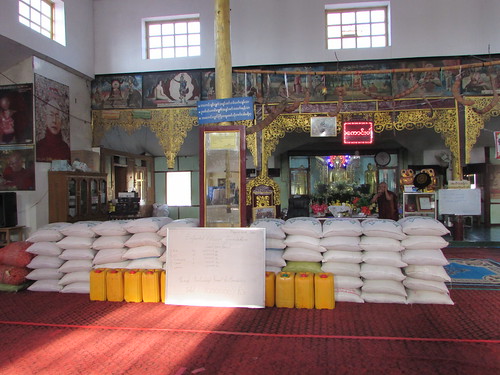
Doe Pin 6th May 2018: The donation of Rice, Cooking Oil, Gram Pea (a type of chickpea), Onions and Potatoes.
The Abbot was informed of our arrival and he appeared, as ebullient and friendly as I remembered him from previous visits. Although there are around 600 boy orphans here, a much smaller number were present for our visit with the balance due to return before the start of the new academic year. Children from 18 different ethnic groups are included in the total. The Abbot summoned the children present, the formal donation was made and lots of photographs were taken to record the event. The younger children sang for us.

Doe Pin 6th May 2018: Dr. Hla Tun, the Abbott and a small group of orphans.
We then drove through the town to reach the Shewe Sin Minn Orphanage for Girls. I think my first visit was in 2011 (described here) but I have made visits since. As at Doe Pin, our aim was to make the formal presentation of a gift from a Swiss charity, Enfants d'Ailleurs Foundation, arranged by Doctor Hla Tun through Belmond 'Road to Mandalay'. This donation, also valued at 2,000,000 Kyat, comprised Rice, Cooking Oil, and artificial meat balls. The open area in front of the buildings was crowded by hundreds of young nuns and orphans.

Shwe Sin Minn Orphanage, 6th May 2018
All told, there are about 600 girls here from four different ethnic groups although not all were present for our visit. I was astounded at the changes in the buildings which had been embellished with typical religious features and re-painted. More new construction was in progress. The orphanage was founded and run by two sisters. The younger one, who is headmistress welcomed us and accepted the donation. The elder sister, who is head nun, appeared briefly. Once again, the purchased food was on display and the formal donation took place with the usual recording of the scene photographically. All the girls then sang for us.
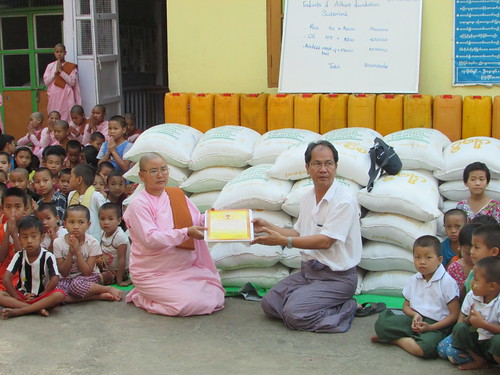
Shwe Sin Minn 6th May 2018: The formal donation of food.
We made a brief visit to Pyin Oo Lwin Hospital, visiting two young Hare Lip patients whose surgery had been paid for by 'Road to Mandalay' guests.

Dr. Hla Tun with Hare Lip patients at Pyin Oo Lwin Hospital 6th May 2018
The Doctor had arranged a visit to the nearby Yadanar Mun Aung monastery. This is a large teaching monastery housed in a number of buildings within the monastery compound. We were given an audience with the abbott, who invited me to overnight in the guesthouse forming part of the monastery but the Doctor declined on my behalf as he had already made arrangements for me to stay in a hotel.
After we left the monastery, I was taken to the Hotel Maymyo. This was a modern, comfortable hotel aiming to encourage tourists. The only problem was that my room was on the 3rd floor (that's 'American' 3rd which the British usually call 'second floor'), the 'Dining Hall' for breakfast was on the 5th floor and there was no lift. I'm a bit slow on stairs these days but it was a minor inconvenience.
Although the hotel served breakfast, it did not provide other meals so I went by car with the others to a tea-shop for dinner. Then they dropped me back at the hotel (they were not staying at the hotel) and I was delighted to find that the hotel had a very usable Wi-Fi.
Related posts on this website
This is one of a series of posts describing my 13th visit to Myanmar.
The post Travelling again is the first post in the series.
Clicking on the 'Next report' link will show the post describing the next events. In this way, you may read about the trip in sequence.
Next report
Alternately, clicking on the 'All my Burma-2018 reports' link displays all the posts on this trip in reverse date-of-posting order.
All my Burma-2018 reports
My pictures
Where necessary, clicking on an image above will display an 'uncropped' view or, alternately, pictures from may be selected, viewed or downloaded, in various sizes, from the albums below:-
Doe Pin 6th May 2018.
Shwe Sin Minn 6th May 2018.
Hare lip patients at Pyin Oo Lwin Hospital.
Hotel Maymyo, Pyin Oo Lwin, 7th May 2018.
All my pictures on this trip to Myanmar can be found at Burma 2018.
['My pictures' links added 4-Aug-2018]
Support for orphanages in Myanmar is described in a number of posts, covering schools and orphanages, labelled 'Education'. You can display them all by clicking here.
Doe Pin orphanage is situated on the Mandalay - Pyin Oo Lwin road, just before you reach Pyin Oo Lwin. I think my last visit was in 2011 (described here).
Our visit to Doe Pin in 2018 was to make the formal presentation of a gift from a Swiss charity, Enfants d'Ailleurs Foundation, arranged by Doctor Hla Tun through Belmond 'Road to Mandalay'. This donation, valued at 2,000,000 Kyat, comprised Rice, Cooking Oil, Gram Pea (a type of chickpea), Onions and Potatoes. When we entered the assembly hall, the purchased food was laid out impressively.

Doe Pin 6th May 2018: The donation of Rice, Cooking Oil, Gram Pea (a type of chickpea), Onions and Potatoes.
The Abbot was informed of our arrival and he appeared, as ebullient and friendly as I remembered him from previous visits. Although there are around 600 boy orphans here, a much smaller number were present for our visit with the balance due to return before the start of the new academic year. Children from 18 different ethnic groups are included in the total. The Abbot summoned the children present, the formal donation was made and lots of photographs were taken to record the event. The younger children sang for us.

Doe Pin 6th May 2018: Dr. Hla Tun, the Abbott and a small group of orphans.
We then drove through the town to reach the Shewe Sin Minn Orphanage for Girls. I think my first visit was in 2011 (described here) but I have made visits since. As at Doe Pin, our aim was to make the formal presentation of a gift from a Swiss charity, Enfants d'Ailleurs Foundation, arranged by Doctor Hla Tun through Belmond 'Road to Mandalay'. This donation, also valued at 2,000,000 Kyat, comprised Rice, Cooking Oil, and artificial meat balls. The open area in front of the buildings was crowded by hundreds of young nuns and orphans.

Shwe Sin Minn Orphanage, 6th May 2018
All told, there are about 600 girls here from four different ethnic groups although not all were present for our visit. I was astounded at the changes in the buildings which had been embellished with typical religious features and re-painted. More new construction was in progress. The orphanage was founded and run by two sisters. The younger one, who is headmistress welcomed us and accepted the donation. The elder sister, who is head nun, appeared briefly. Once again, the purchased food was on display and the formal donation took place with the usual recording of the scene photographically. All the girls then sang for us.

Shwe Sin Minn 6th May 2018: The formal donation of food.
We made a brief visit to Pyin Oo Lwin Hospital, visiting two young Hare Lip patients whose surgery had been paid for by 'Road to Mandalay' guests.

Dr. Hla Tun with Hare Lip patients at Pyin Oo Lwin Hospital 6th May 2018
The Doctor had arranged a visit to the nearby Yadanar Mun Aung monastery. This is a large teaching monastery housed in a number of buildings within the monastery compound. We were given an audience with the abbott, who invited me to overnight in the guesthouse forming part of the monastery but the Doctor declined on my behalf as he had already made arrangements for me to stay in a hotel.
After we left the monastery, I was taken to the Hotel Maymyo. This was a modern, comfortable hotel aiming to encourage tourists. The only problem was that my room was on the 3rd floor (that's 'American' 3rd which the British usually call 'second floor'), the 'Dining Hall' for breakfast was on the 5th floor and there was no lift. I'm a bit slow on stairs these days but it was a minor inconvenience.
Although the hotel served breakfast, it did not provide other meals so I went by car with the others to a tea-shop for dinner. Then they dropped me back at the hotel (they were not staying at the hotel) and I was delighted to find that the hotel had a very usable Wi-Fi.
Related posts on this website
This is one of a series of posts describing my 13th visit to Myanmar.
The post Travelling again is the first post in the series.
Clicking on the 'Next report' link will show the post describing the next events. In this way, you may read about the trip in sequence.
Next report
Alternately, clicking on the 'All my Burma-2018 reports' link displays all the posts on this trip in reverse date-of-posting order.
All my Burma-2018 reports
My pictures
Where necessary, clicking on an image above will display an 'uncropped' view or, alternately, pictures from may be selected, viewed or downloaded, in various sizes, from the albums below:-
Doe Pin 6th May 2018.
Shwe Sin Minn 6th May 2018.
Hare lip patients at Pyin Oo Lwin Hospital.
Hotel Maymyo, Pyin Oo Lwin, 7th May 2018.
All my pictures on this trip to Myanmar can be found at Burma 2018.
['My pictures' links added 4-Aug-2018]
Monday 7 May 2018
Leaving Bagan Medical Clinic for Pyin Oo Lwin
Sunday, 6th May 2018
By continuing to see patients on Saturday night until one o'clock in the morning, Doctor Hla Tun was left with around twelve patients still to see on Sunday morning. He started his consultations a little after 7.00 a.m. in the hope of being finished before noon but each patient always receives all the time they need and, with some complex cases, it was after 2 p.m. before we were ready to leave, with over 600 patients having been seen that weekend.
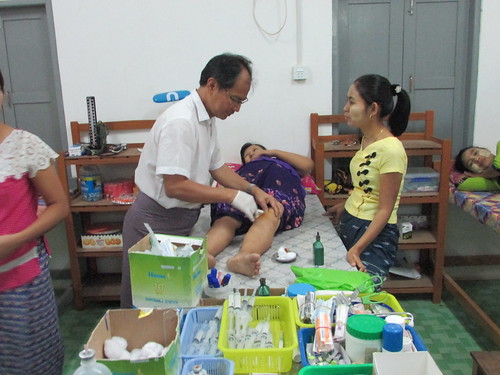
Bagan Clinic 6th May 2018: Doctor Hla Tun at work.
As always, I was sad to be leaving my friends at the Clinic which was now much quieter as patients started their often arduous journeys home.
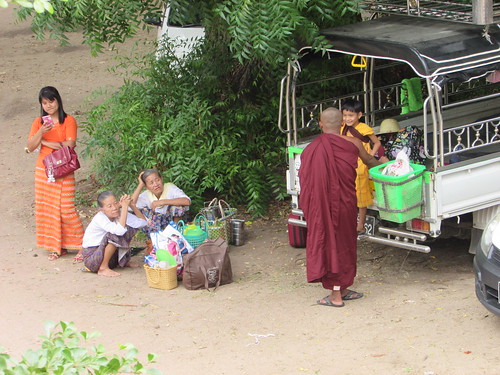
Bagan Clinic 6th May 2018: A group of patients preparing to travel home.
By Sunday afternoon, a number of the retail stall holders had also packed up and left.
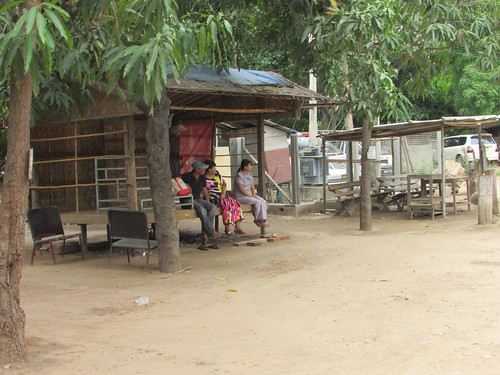
Bagan Clinic 6th May 2018: By Sunday afternoon, a number of the retail stall holders had packed-up and left.
At the Doctor's insistence, I'd been given lunch (yes, congee and a plain omelette with a can of Coca Cola). To prepare me for the journey, they also gave me soup and fresh fruit. The Doctor himself intended to skip lunch but the staff made sure he took something from the wide range of dishes available which he consumed whilst standing.
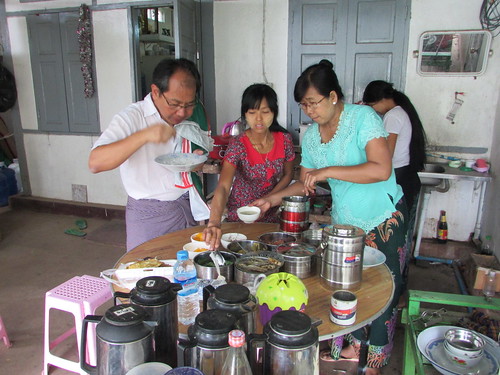
The Doctor takes a hasty lunch.
The Doctor and I were to travel in a monastery saloon car with a different driver who was familiar with the Mandalay area. An attractive young lady who works for Belmond with good English was to accompany us on our trip.
We left Bagan Medical Clinic and drove across the Plain of Bagan with its numerous pagodas which I always find magical.
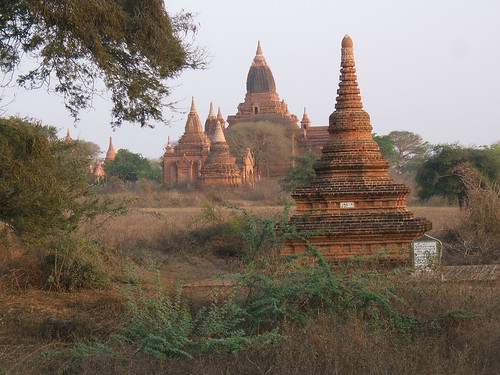
Bagan Pagodas.
At Nyaung Oo we headed north on a good road I'd not travelled before towards Mandalay. We passed a deteriorating concrete bridge over a watercourse which was shared by a single line railway. Small toll stations were provided on either side of the bridge.
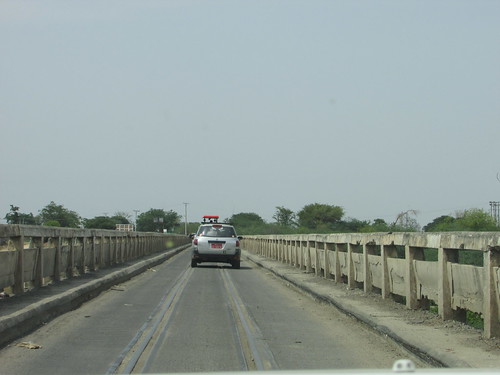
Bagan to Pyin Oo Lwin 6th May 2018: Deteriorating concrete bridge shared by a single line railway.
In the substantial city of Myingyan, the broad main road had the concrete poles for power distribution running down the middle, with the usual untidy festoon of cables to buildings on both sides of the road and various types of street lighting fittings strapped to the poles.

Bagan to Pyin Oo Lwin 6th May 2018: Myingyan.
The road turned east and intersected the Yangon - Mandalay Expressway which we joined, heading north towards Mandalay. At the toll station near Mandalay International Airport, we turned off towards Paliek and Myitnge. After about three hours travelling, we stopped briefly for sweet tea at a tea-shop near Myitnge then by-passed Mandalay itself to take the road to Pyin Oo Lwin.
The changes here since my last road trip to Pyin Oo Lwin were remarkable. The road, the 'Oriental Highway', is operated by a private company and massive road works are in progress at the Mandalay end of the route. Beyond Pyin Oo Lwin the road continues through Lashio to an important border crossing into China so the route carries immense amounts of heavy lorries. From the plains at Mandalay, the road climbs 3,500 feet to Pyin Oo Lwin so we were frequently passing crawling heavy lorries.
Pyin Oo Lwin was chosen by the Britsh at their 'Hill Station' (the term is still used in Myanmar) and called Maymyo, 'May's town' after a British colonel of that name. This gave the British somewhere to escape the heat of the plains in summer and older parts of the town still have the atmosphere of England, although modern rather nondescript development is less attractive, swelling the population to around 255,000. There's a Wikipedia article on the town here.
Related posts on this website
This is one of a series of posts describing my 13th visit to Myanmar.
The post Travelling again is the first post in the series.
Clicking on the 'Next report' link will show the post describing the next events. In this way, you may read about the trip in sequence.
Next report
Alternately, clicking on the 'All my Burma-2018 reports' link displays all the posts on this trip in reverse date-of-posting order.
All my Burma-2018 reports
My pictures
Where necessary, clicking on an image above will display an 'uncropped' view or, alternately, pictures from may be selected, viewed or downloaded, in various sizes, from the albums below:-
Bagan Medical Clinic 2nd weekend
Bagan to Pyin Oo Lwin 6th May 2018
All my pictures on this trip to Myanmar can be found at Burma 2018.
[Patient numbers and 'Next' link added 8-May-2018: Edits, pictures linked, pictures inserted 26-Jun-2018]
By continuing to see patients on Saturday night until one o'clock in the morning, Doctor Hla Tun was left with around twelve patients still to see on Sunday morning. He started his consultations a little after 7.00 a.m. in the hope of being finished before noon but each patient always receives all the time they need and, with some complex cases, it was after 2 p.m. before we were ready to leave, with over 600 patients having been seen that weekend.

Bagan Clinic 6th May 2018: Doctor Hla Tun at work.
As always, I was sad to be leaving my friends at the Clinic which was now much quieter as patients started their often arduous journeys home.

Bagan Clinic 6th May 2018: A group of patients preparing to travel home.
By Sunday afternoon, a number of the retail stall holders had also packed up and left.

Bagan Clinic 6th May 2018: By Sunday afternoon, a number of the retail stall holders had packed-up and left.
At the Doctor's insistence, I'd been given lunch (yes, congee and a plain omelette with a can of Coca Cola). To prepare me for the journey, they also gave me soup and fresh fruit. The Doctor himself intended to skip lunch but the staff made sure he took something from the wide range of dishes available which he consumed whilst standing.

The Doctor takes a hasty lunch.
The Doctor and I were to travel in a monastery saloon car with a different driver who was familiar with the Mandalay area. An attractive young lady who works for Belmond with good English was to accompany us on our trip.
We left Bagan Medical Clinic and drove across the Plain of Bagan with its numerous pagodas which I always find magical.

Bagan Pagodas.
At Nyaung Oo we headed north on a good road I'd not travelled before towards Mandalay. We passed a deteriorating concrete bridge over a watercourse which was shared by a single line railway. Small toll stations were provided on either side of the bridge.

Bagan to Pyin Oo Lwin 6th May 2018: Deteriorating concrete bridge shared by a single line railway.
In the substantial city of Myingyan, the broad main road had the concrete poles for power distribution running down the middle, with the usual untidy festoon of cables to buildings on both sides of the road and various types of street lighting fittings strapped to the poles.

Bagan to Pyin Oo Lwin 6th May 2018: Myingyan.
The road turned east and intersected the Yangon - Mandalay Expressway which we joined, heading north towards Mandalay. At the toll station near Mandalay International Airport, we turned off towards Paliek and Myitnge. After about three hours travelling, we stopped briefly for sweet tea at a tea-shop near Myitnge then by-passed Mandalay itself to take the road to Pyin Oo Lwin.
The changes here since my last road trip to Pyin Oo Lwin were remarkable. The road, the 'Oriental Highway', is operated by a private company and massive road works are in progress at the Mandalay end of the route. Beyond Pyin Oo Lwin the road continues through Lashio to an important border crossing into China so the route carries immense amounts of heavy lorries. From the plains at Mandalay, the road climbs 3,500 feet to Pyin Oo Lwin so we were frequently passing crawling heavy lorries.
Pyin Oo Lwin was chosen by the Britsh at their 'Hill Station' (the term is still used in Myanmar) and called Maymyo, 'May's town' after a British colonel of that name. This gave the British somewhere to escape the heat of the plains in summer and older parts of the town still have the atmosphere of England, although modern rather nondescript development is less attractive, swelling the population to around 255,000. There's a Wikipedia article on the town here.
Related posts on this website
This is one of a series of posts describing my 13th visit to Myanmar.
The post Travelling again is the first post in the series.
Clicking on the 'Next report' link will show the post describing the next events. In this way, you may read about the trip in sequence.
Next report
Alternately, clicking on the 'All my Burma-2018 reports' link displays all the posts on this trip in reverse date-of-posting order.
All my Burma-2018 reports
My pictures
Where necessary, clicking on an image above will display an 'uncropped' view or, alternately, pictures from may be selected, viewed or downloaded, in various sizes, from the albums below:-
Bagan Medical Clinic 2nd weekend
Bagan to Pyin Oo Lwin 6th May 2018
All my pictures on this trip to Myanmar can be found at Burma 2018.
[Patient numbers and 'Next' link added 8-May-2018: Edits, pictures linked, pictures inserted 26-Jun-2018]
Sunday 6 May 2018
A second weekend at Bagan Medical Clinic (2)
Saturday, 5th May 2018
Having slept well, I ventured outside just before seven, I immediately came across the Abbott, showing a Myanmar lady and her 20-year old daughter around the Clinic. The daughter spoke English, so we chatted for a minute or two.
It had been agreed that I would go to Htee Pu and make a distribution of stationery. The Doctor had ensured that the stationery was available at the Clinic so the monastery car was loaded and the driver and I set off at 8.00 a.m. on the familiar route to Htee Pu. The last couple of miles to Htee Pu village used to be a nightmare over an undulating earth road but, on my last visit, road improvements were in progress and we found that, now the work was completed, access to Htee Pu is much improved, although the last section through the village to the monastery and school remains a rutted, earth road.
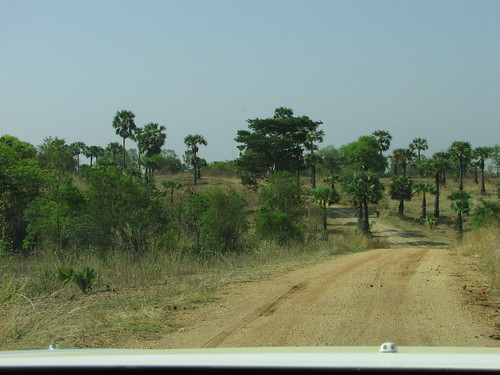
Visit to Htee Pu 5th May 2018: The improved road from the main road to the village.
We were greeted by the abbot and three lady teachers. Three tables were set up in the shade of a large tree in the dirt playground and we unpacked the bulk supplies of exercise books, pencils and plastic rulers and assembled over 100 ‘kits’ comprising 5 good-quality ruled exercise books, three pencils each with a eraser tip, and a plastic ruler. I noted, with approval, that all the packaging materials were being carefully collected in a black plastic bag and a woven basket. Htee Pu school tries to inculcate a responsible attitude to litter in its pupils. In general, Myanmar people are some of the friendliest in the world but it has to be said that they are also some of the worst offenders in thoughtlessly tossing litter aside.
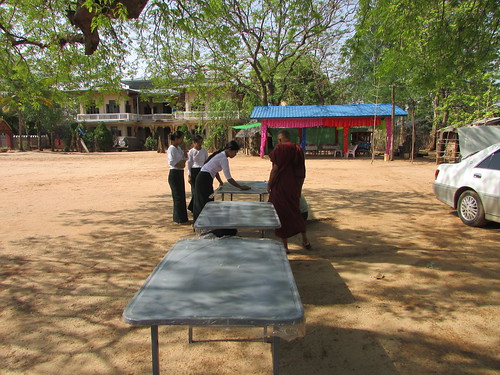
Visit to Htee Pu 5th May 2018: Three tables were set up in the shade of a large tree. The monastery building can be seen in the background.
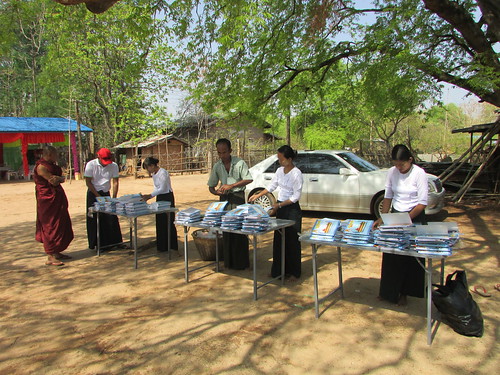
Visit to Htee Pu 5th May 2018: Exercise books, pencils and plastic rulers were assembled into over 100 ‘kits.’
There was no sign of any children. It was hard to believe that over 100 excited children were waiting noiselessly in the adjacent assembly hall.
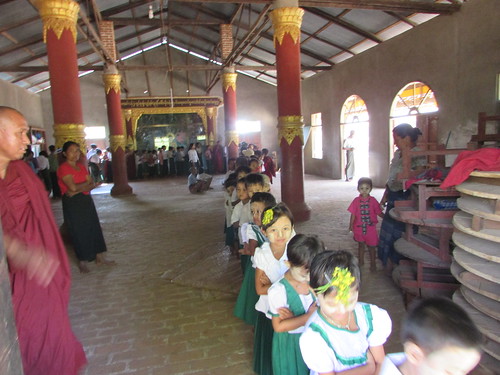
Visit to Htee Pu 5th May 2018: The Assembly Hall where the children were quietly waiting.
Once the stationery 'kits' were ready, the teachers brought out the children in single file, youngest first. Because of the good organisation, it didn't take long to present the distribution.
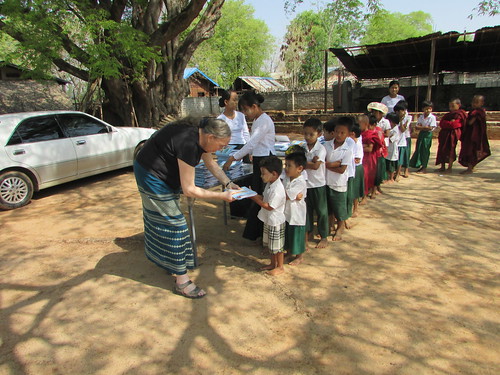


Distribution complete, the children quickly disappeared (this visit took place during their summer school holiday) and the abbott, teachers and I sat for a while in a decorated pavilion where refreshments had been provided.

Visit to Htee Pu 5th May 2018: Refreshments in the Pavilion.
Afterwards, the abbott took me to check the various classrooms which had been provided as part of the ‘Road to Mandalay’ Social Contribution. I'd attended the opening ceremony, back in 2010, of one of these buildings (there's a description of that opening here).

Visit to Htee Pu 5th May 2018: Current view of the building opened in 2010.
Finally, we said 'good-bye' to our friendly hosts and the driver and I returned to Bagan Medical Clinic. As usual, the main road back to Nyaung Oo had road works in progress. I think major repairs are required each year following the season of heavy rain but there is also a serious attempt to generally improve the road infrastructure in Myanmar.
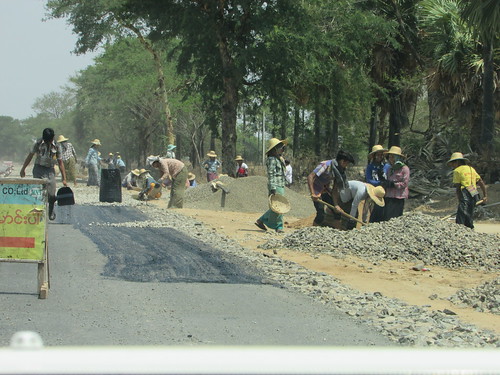
Visit to Htee Pu 5th May 2018: Roadbuilding on the Nyaung Oo-Mount Popa road.
Safely back in Bagan, I spent the rest of the day either trying to write text files ready to upload to the internet once I had a connection, backing up photographs or observing in Doctor Hla Tun’s consulting room. Once again, I retired well before the Doctor.
Related posts on this website
This is one of a series of posts describing my 13th visit to Myanmar.
The post Travelling again is the first post in the series.
Clicking on the 'Next report' link will show the post describing the next events. In this way, you may read about the trip in sequence.
Next report
Alternately, clicking on the 'All my Burma-2018 reports' link displays all the posts on this trip in reverse date-of-posting order.
All my Burma-2018 reports
My pictures
Bagan Medical Clinic 2nd weekend
Visit to Htee Pu 5th May 2018
All my pictures on this trip to Myanmar can be found at Burma 2018.
[Pictures linked, minor edits and pictures embedded 22-Jun-2018]
Having slept well, I ventured outside just before seven, I immediately came across the Abbott, showing a Myanmar lady and her 20-year old daughter around the Clinic. The daughter spoke English, so we chatted for a minute or two.
It had been agreed that I would go to Htee Pu and make a distribution of stationery. The Doctor had ensured that the stationery was available at the Clinic so the monastery car was loaded and the driver and I set off at 8.00 a.m. on the familiar route to Htee Pu. The last couple of miles to Htee Pu village used to be a nightmare over an undulating earth road but, on my last visit, road improvements were in progress and we found that, now the work was completed, access to Htee Pu is much improved, although the last section through the village to the monastery and school remains a rutted, earth road.

Visit to Htee Pu 5th May 2018: The improved road from the main road to the village.
We were greeted by the abbot and three lady teachers. Three tables were set up in the shade of a large tree in the dirt playground and we unpacked the bulk supplies of exercise books, pencils and plastic rulers and assembled over 100 ‘kits’ comprising 5 good-quality ruled exercise books, three pencils each with a eraser tip, and a plastic ruler. I noted, with approval, that all the packaging materials were being carefully collected in a black plastic bag and a woven basket. Htee Pu school tries to inculcate a responsible attitude to litter in its pupils. In general, Myanmar people are some of the friendliest in the world but it has to be said that they are also some of the worst offenders in thoughtlessly tossing litter aside.

Visit to Htee Pu 5th May 2018: Three tables were set up in the shade of a large tree. The monastery building can be seen in the background.

Visit to Htee Pu 5th May 2018: Exercise books, pencils and plastic rulers were assembled into over 100 ‘kits.’
There was no sign of any children. It was hard to believe that over 100 excited children were waiting noiselessly in the adjacent assembly hall.

Visit to Htee Pu 5th May 2018: The Assembly Hall where the children were quietly waiting.
Once the stationery 'kits' were ready, the teachers brought out the children in single file, youngest first. Because of the good organisation, it didn't take long to present the distribution.



Distribution complete, the children quickly disappeared (this visit took place during their summer school holiday) and the abbott, teachers and I sat for a while in a decorated pavilion where refreshments had been provided.

Visit to Htee Pu 5th May 2018: Refreshments in the Pavilion.
Afterwards, the abbott took me to check the various classrooms which had been provided as part of the ‘Road to Mandalay’ Social Contribution. I'd attended the opening ceremony, back in 2010, of one of these buildings (there's a description of that opening here).

Visit to Htee Pu 5th May 2018: Current view of the building opened in 2010.
Finally, we said 'good-bye' to our friendly hosts and the driver and I returned to Bagan Medical Clinic. As usual, the main road back to Nyaung Oo had road works in progress. I think major repairs are required each year following the season of heavy rain but there is also a serious attempt to generally improve the road infrastructure in Myanmar.

Visit to Htee Pu 5th May 2018: Roadbuilding on the Nyaung Oo-Mount Popa road.
Safely back in Bagan, I spent the rest of the day either trying to write text files ready to upload to the internet once I had a connection, backing up photographs or observing in Doctor Hla Tun’s consulting room. Once again, I retired well before the Doctor.
Related posts on this website
This is one of a series of posts describing my 13th visit to Myanmar.
The post Travelling again is the first post in the series.
Clicking on the 'Next report' link will show the post describing the next events. In this way, you may read about the trip in sequence.
Next report
Alternately, clicking on the 'All my Burma-2018 reports' link displays all the posts on this trip in reverse date-of-posting order.
All my Burma-2018 reports
My pictures
Bagan Medical Clinic 2nd weekend
Visit to Htee Pu 5th May 2018
All my pictures on this trip to Myanmar can be found at Burma 2018.
[Pictures linked, minor edits and pictures embedded 22-Jun-2018]
A second Weekend at Bagan Medical Clinic
Friday, 4th May 2018
When we arrived back from Chin State on Thursday evening, 74 patients had already registered for Friday but we knew that more were on their way to the Clinic.
The Doctor’s wife was returning to Yangon on Friday so, after we had breakfast together just before 7.00 a.m., the monastery car whisked her to Nyaung Oo Airport, in time to catch the 08:20 flight to Yangon. This flight is not direct but makes calls at Mandalay and Heho, and is due Yangon 11:00.
The Doctor started consultations before eight o’clock and I observed for a while. An attractive, well-dressed lady came into the consulting room, whom the Doctor introduced to me as the Dentist.

Bagan Medical Clinic 2nd weekend: The visiting dentist observes the lunch distribution.
There’s a public address system in the compound over which a man periodically broadcasts what is, I believe, an appeal for funds. There are certainly a number of clear-sided collecting boxes around the site, of the type you find in pagodas.
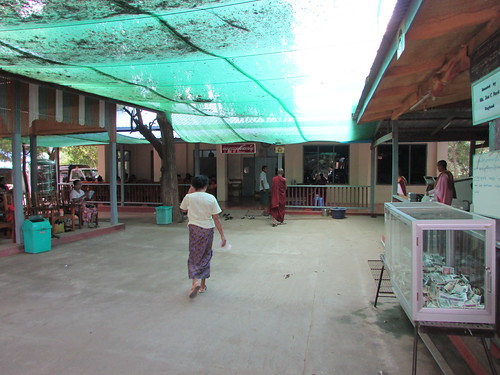
Bagan Medical Clinic with two clear-sided Donation Boxes visible on the right.
When the free lunch is ready, an announcement is made over the public address which I didn’t hear on Friday but the Doctor prompted me to go and witness this inspiring event. As I walked to the distribution point, a long queue was forming and the Abbot had started handing out meals.

Bagan Medical Clinic 2nd weekend: the Abbott distributing free lunches to patients and their companions.
As soon as the Abbot saw me, he waved me across and I took over. Of course, all the work is done by the team of volunteers loading the metal plates with a generous portion of steamed rice followed by two or three other items which vary day-by-day.

Bagan Medical Clinic 2nd weekend: Plates with free lunches being made up by clinic staff and volunteers.
Sometimes, a person will collect the meal for one or two companions but somebody was on hand to prompt me if I failed to understand a request for extra meals. I’m always pleased to watch the meal distribution as it seems to represent an excellent basis for a philosophy of life and I'm humbled when asked to participate.
Although the 2-storey building had been put into use, full utilisation and completion of the adjacent 28-bed hospital recovery unit is dependent upon the receipt of donations. Building adaptions had been agreed to improve access to the upper floor of the 2-storey building and I was pleased to see builders at work on the new stairway on the river elevation of the buildingh. Although each flight of stairs has been cast on site from concrete, the final profile of each step was being defined by cementing bricks in place. Two bricklayers were working down the stairs, taking the required bricks from an adjacent small pile being kept topped-up by lady labourer.

Bagan Medical Clinic 2nd weekend. Bricklayers working on the new staircase.
What I found remarkable was that the lady, just wearing a wide-brimmed floppy, woven sun hat, was somehow balancing twelve bricks on her head, six on the left, six on the right, climbing the rough-cast stairs to where the men were working and then slowly crouching down to cautiously unload the bricks (unaided), one from the left, one from the right until another dozen bricks were safely in the pile ready for the bricklayers to use.

Bagan Medical Clinic 2nd weekend: Having transported more bricks upstairs, the labourer positions them ready for the bricklayers.
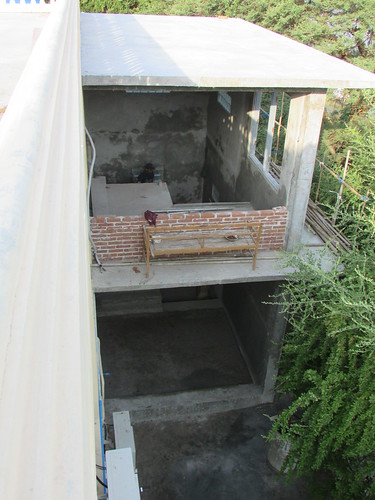
Bagan Medical Clinic 2nd weekend: River elevation of 2-storey building showing stairway extension under construction.
I was quite tired after our intensive trip to Chin State so, other than periodic strolls around the compound marvelling at all the activity, I divided my time between observing the Doctor and his team dealing with a wide variety of cases and working on my computer offline in my room.
Although I took my regular meal at 1.00 p.m., the Doctor only snacked but finally, after 8.00 p.m., he stopped briefly for an evening meal before continuing consultations until after 1.00 a.m. by which time I was sound asleep.
Related posts on this website
This is one of a series of posts describing my 13th visit to Myanmar.
The post Travelling again is the first post in the series.
Clicking on the 'Next report' link will show the post describing the next events. In this way, you may read about the trip in sequence.
Next report
Alternately, clicking on the 'All my Burma-2018 reports' link displays all the posts on this trip in reverse date-of-posting order.
All my Burma-2018 reports
My pictures
Bagan Medical Clinic 2nd weekend
All my pictures on this trip to Myanmar can be found at Burma 2018.
[Pictures linked, minor edits and pictures embedded 19-Jun-2018]
When we arrived back from Chin State on Thursday evening, 74 patients had already registered for Friday but we knew that more were on their way to the Clinic.
The Doctor’s wife was returning to Yangon on Friday so, after we had breakfast together just before 7.00 a.m., the monastery car whisked her to Nyaung Oo Airport, in time to catch the 08:20 flight to Yangon. This flight is not direct but makes calls at Mandalay and Heho, and is due Yangon 11:00.
The Doctor started consultations before eight o’clock and I observed for a while. An attractive, well-dressed lady came into the consulting room, whom the Doctor introduced to me as the Dentist.

Bagan Medical Clinic 2nd weekend: The visiting dentist observes the lunch distribution.
There’s a public address system in the compound over which a man periodically broadcasts what is, I believe, an appeal for funds. There are certainly a number of clear-sided collecting boxes around the site, of the type you find in pagodas.

Bagan Medical Clinic with two clear-sided Donation Boxes visible on the right.
When the free lunch is ready, an announcement is made over the public address which I didn’t hear on Friday but the Doctor prompted me to go and witness this inspiring event. As I walked to the distribution point, a long queue was forming and the Abbot had started handing out meals.

Bagan Medical Clinic 2nd weekend: the Abbott distributing free lunches to patients and their companions.
As soon as the Abbot saw me, he waved me across and I took over. Of course, all the work is done by the team of volunteers loading the metal plates with a generous portion of steamed rice followed by two or three other items which vary day-by-day.

Bagan Medical Clinic 2nd weekend: Plates with free lunches being made up by clinic staff and volunteers.
Sometimes, a person will collect the meal for one or two companions but somebody was on hand to prompt me if I failed to understand a request for extra meals. I’m always pleased to watch the meal distribution as it seems to represent an excellent basis for a philosophy of life and I'm humbled when asked to participate.
Although the 2-storey building had been put into use, full utilisation and completion of the adjacent 28-bed hospital recovery unit is dependent upon the receipt of donations. Building adaptions had been agreed to improve access to the upper floor of the 2-storey building and I was pleased to see builders at work on the new stairway on the river elevation of the buildingh. Although each flight of stairs has been cast on site from concrete, the final profile of each step was being defined by cementing bricks in place. Two bricklayers were working down the stairs, taking the required bricks from an adjacent small pile being kept topped-up by lady labourer.

Bagan Medical Clinic 2nd weekend. Bricklayers working on the new staircase.
What I found remarkable was that the lady, just wearing a wide-brimmed floppy, woven sun hat, was somehow balancing twelve bricks on her head, six on the left, six on the right, climbing the rough-cast stairs to where the men were working and then slowly crouching down to cautiously unload the bricks (unaided), one from the left, one from the right until another dozen bricks were safely in the pile ready for the bricklayers to use.

Bagan Medical Clinic 2nd weekend: Having transported more bricks upstairs, the labourer positions them ready for the bricklayers.

Bagan Medical Clinic 2nd weekend: River elevation of 2-storey building showing stairway extension under construction.
I was quite tired after our intensive trip to Chin State so, other than periodic strolls around the compound marvelling at all the activity, I divided my time between observing the Doctor and his team dealing with a wide variety of cases and working on my computer offline in my room.
Although I took my regular meal at 1.00 p.m., the Doctor only snacked but finally, after 8.00 p.m., he stopped briefly for an evening meal before continuing consultations until after 1.00 a.m. by which time I was sound asleep.
Related posts on this website
This is one of a series of posts describing my 13th visit to Myanmar.
The post Travelling again is the first post in the series.
Clicking on the 'Next report' link will show the post describing the next events. In this way, you may read about the trip in sequence.
Next report
Alternately, clicking on the 'All my Burma-2018 reports' link displays all the posts on this trip in reverse date-of-posting order.
All my Burma-2018 reports
My pictures
Bagan Medical Clinic 2nd weekend
All my pictures on this trip to Myanmar can be found at Burma 2018.
[Pictures linked, minor edits and pictures embedded 19-Jun-2018]
By Road to Bagan
Thursday, 3rd May 2018
I slept well and, at 7.00 a.m., took a light breakfast at Hotel Moe with the Doctor and his wife. The Doctor said that I could continue to work on the internet for a while whilst he arranged for our monastery car to pick us up at the hotel.
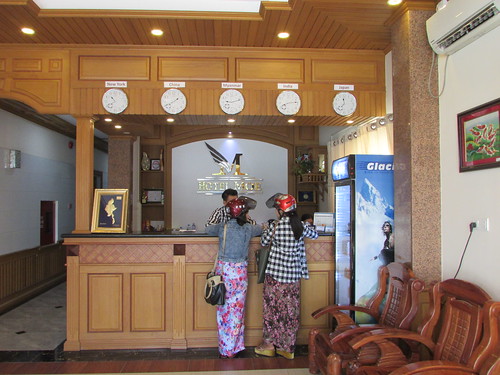
By road to Bagan 3rd May 2018: Reception at Hotel Moe, Kalay.
We set off on the long journey back to Bagan at about half past nine, in our repaired Toyota Land Cruiser Prado TZ with our original monastery driver.
At the Monk’s lunch time, we pulled in at a large tea-shop, one of a large number branded ‘DAGON STATION’ (I assume the name is intend to convey a similar meaning to ‘petrol station’), selling the products of Dagon Beverages Co. Ltd which carry the image of a lion. The Monk was very swiftly served and the rest of us agreed to eat a little later in the day.

By road to Bagan 3rd May 2018: The large roadside cafe (a 'Dagon Station') where the monk took lunch.
After continuing south for a while, we made a left turn and were back on unsealed roads of variable quality. A single track railway appeared and our road seemed to be following the railway route. We were headed towards mountains and eventually it became clear that we had some serious climbing ahead of us. But whilst I periodically lost sight of the railway as it made generous detours to ease the ruling gradient, the road (which must date from the ‘internal combustion’ era) tended to attack the climbs more head-on but, in the difficult terrain, lots of twisting and very sharp hairpin bends were still necessary.
Up in the hills, we suddenly came upon a modern petrol station looking, to me, rather out of place. Here, we took fuel.

By road to Bagan 3rd May 2018: A filling station in the mountain area.
We carried on over some difficult hill sections. I was completely disoriented by all the twisting and turning. Abruptly, we pulled up at a tea-shop where the Doctor, his wife and the writer finally took lunch whilst the monk rested. The afternoon was hot and there were flies everywhere. We ate to the accompaniment of banging from builders attaching aluminium-zinc corrugated roof sheeting to the wooden framework of an extension to the building we were in. But I found it a pleasant break from travelling on unsealed roads.

By road to Bagan 3rd May 2018: Tea shop near Diamond Mountain.
As we left the tea shop, I admired a Doosan DISD SD300N loading shovel being carefully cleaned by two men.

By road to Bagan 3rd May 2018: Doosan DISD SD300N loader being cleaned near Diamond Mountain.
Shortly afterwards, we found the way ahead completely blocked by a tipper lorry positioned across the roadway while it tipped earth at the side of the road, perhaps for building up the verges. An impatient 8-wheel lorry travelling the towards us was continuously sounding his horn. Eventually, the tipper lorry managed to back enough to clear a path for the 8-wheeler, then resuming tipping. The 8-wheeler crept forward but then found his path blocked by a motor cycle parked at the edge of the road. This triggered more furious horn blowing. When this produced no effect, the driver’s assistant jumped from the cab and moved the offending machine well clear of the carriageway, carefully replacing it on its stand. After this little drama, we were able to continue.
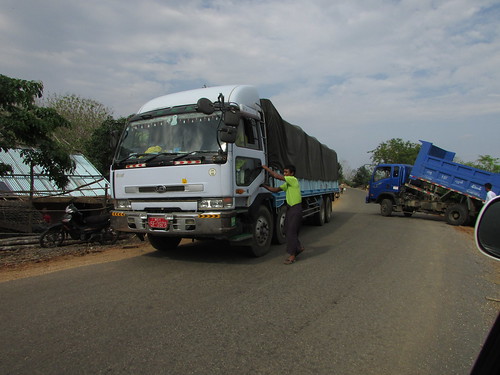
By road to Bagan 3rd May 2018: Having moved a motor cycle, the 8-wheeler can pass the blue tipper lorry.
Our final stop, as it grew dark, was at the Thiho Shin Pagoda in Pakokku. The spire of the pagoda was covered in the delicate cocoon of interlaced bamboo always used by pagoda builders when carrying out repairs or re-gilding.
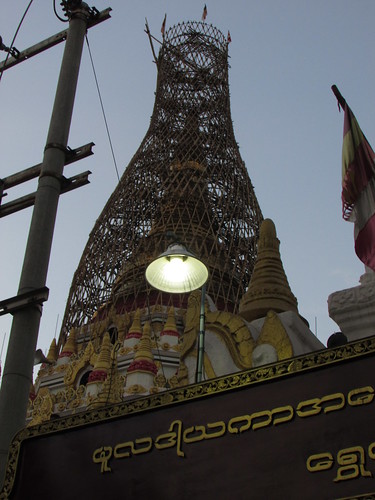
By road to Bagan 3rd May 2018: Thiho Shin Pagoda, Pakokku at dusk, showing bamboo scaffolding.
The pagoda houses a massive, intricate wood carving constructed in five sections which took a father and son four years to carve over a century ago. Many pilgrims visit to admire this remarkable work. Nearby, there are old photographs of the father and son craftsman and the elderly couple who donated the work.
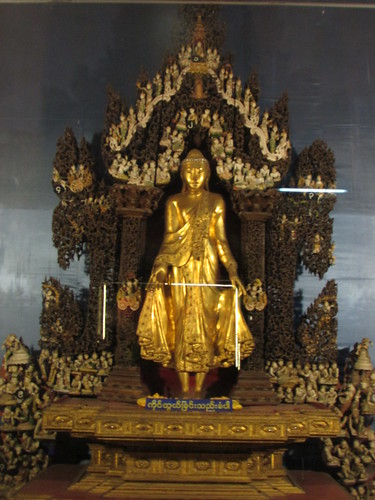
By road to Bagan 3rd May 2018: Thiho Shin Pagoda, Pakokku showing the famous intricate wood carving.
We then used the lengthy Pakokku road and rail bridge to return to the east bank of the Ayeyarwaddy River. From there, it was back to Nyaung Oo and finally, travelling on familiar roads, back to Bagan Medical Clinic where we were greeted by the staff who immediately made preparations for our dinner.
Related posts on this website
This is one of a series of posts describing my 13th visit to Myanmar.
The post Travelling again is the first post in the series.
Clicking on the 'Next report' link will show the post describing the next events. In this way, you may read about the trip in sequence.
Next report
Alternately, clicking on the 'All my Burma-2018 reports' link displays all the posts on this trip in reverse date-of-posting order.
All my Burma-2018 reports
My pictures
By road to Bagan 3rd May 2018
Hotel Moe, Kalay, Myanmar
All my pictures on this trip to Myanmar can be found at Burma 2018.
[Pictures linked 10-May-2018, minor edits and pictures embedded 13-Jun-2018]
I slept well and, at 7.00 a.m., took a light breakfast at Hotel Moe with the Doctor and his wife. The Doctor said that I could continue to work on the internet for a while whilst he arranged for our monastery car to pick us up at the hotel.

By road to Bagan 3rd May 2018: Reception at Hotel Moe, Kalay.
We set off on the long journey back to Bagan at about half past nine, in our repaired Toyota Land Cruiser Prado TZ with our original monastery driver.
At the Monk’s lunch time, we pulled in at a large tea-shop, one of a large number branded ‘DAGON STATION’ (I assume the name is intend to convey a similar meaning to ‘petrol station’), selling the products of Dagon Beverages Co. Ltd which carry the image of a lion. The Monk was very swiftly served and the rest of us agreed to eat a little later in the day.

By road to Bagan 3rd May 2018: The large roadside cafe (a 'Dagon Station') where the monk took lunch.
After continuing south for a while, we made a left turn and were back on unsealed roads of variable quality. A single track railway appeared and our road seemed to be following the railway route. We were headed towards mountains and eventually it became clear that we had some serious climbing ahead of us. But whilst I periodically lost sight of the railway as it made generous detours to ease the ruling gradient, the road (which must date from the ‘internal combustion’ era) tended to attack the climbs more head-on but, in the difficult terrain, lots of twisting and very sharp hairpin bends were still necessary.
Up in the hills, we suddenly came upon a modern petrol station looking, to me, rather out of place. Here, we took fuel.

By road to Bagan 3rd May 2018: A filling station in the mountain area.
We carried on over some difficult hill sections. I was completely disoriented by all the twisting and turning. Abruptly, we pulled up at a tea-shop where the Doctor, his wife and the writer finally took lunch whilst the monk rested. The afternoon was hot and there were flies everywhere. We ate to the accompaniment of banging from builders attaching aluminium-zinc corrugated roof sheeting to the wooden framework of an extension to the building we were in. But I found it a pleasant break from travelling on unsealed roads.

By road to Bagan 3rd May 2018: Tea shop near Diamond Mountain.
As we left the tea shop, I admired a Doosan DISD SD300N loading shovel being carefully cleaned by two men.

By road to Bagan 3rd May 2018: Doosan DISD SD300N loader being cleaned near Diamond Mountain.
Shortly afterwards, we found the way ahead completely blocked by a tipper lorry positioned across the roadway while it tipped earth at the side of the road, perhaps for building up the verges. An impatient 8-wheel lorry travelling the towards us was continuously sounding his horn. Eventually, the tipper lorry managed to back enough to clear a path for the 8-wheeler, then resuming tipping. The 8-wheeler crept forward but then found his path blocked by a motor cycle parked at the edge of the road. This triggered more furious horn blowing. When this produced no effect, the driver’s assistant jumped from the cab and moved the offending machine well clear of the carriageway, carefully replacing it on its stand. After this little drama, we were able to continue.

By road to Bagan 3rd May 2018: Having moved a motor cycle, the 8-wheeler can pass the blue tipper lorry.
Our final stop, as it grew dark, was at the Thiho Shin Pagoda in Pakokku. The spire of the pagoda was covered in the delicate cocoon of interlaced bamboo always used by pagoda builders when carrying out repairs or re-gilding.

By road to Bagan 3rd May 2018: Thiho Shin Pagoda, Pakokku at dusk, showing bamboo scaffolding.
The pagoda houses a massive, intricate wood carving constructed in five sections which took a father and son four years to carve over a century ago. Many pilgrims visit to admire this remarkable work. Nearby, there are old photographs of the father and son craftsman and the elderly couple who donated the work.

By road to Bagan 3rd May 2018: Thiho Shin Pagoda, Pakokku showing the famous intricate wood carving.
We then used the lengthy Pakokku road and rail bridge to return to the east bank of the Ayeyarwaddy River. From there, it was back to Nyaung Oo and finally, travelling on familiar roads, back to Bagan Medical Clinic where we were greeted by the staff who immediately made preparations for our dinner.
Related posts on this website
This is one of a series of posts describing my 13th visit to Myanmar.
The post Travelling again is the first post in the series.
Clicking on the 'Next report' link will show the post describing the next events. In this way, you may read about the trip in sequence.
Next report
Alternately, clicking on the 'All my Burma-2018 reports' link displays all the posts on this trip in reverse date-of-posting order.
All my Burma-2018 reports
My pictures
By road to Bagan 3rd May 2018
Hotel Moe, Kalay, Myanmar
All my pictures on this trip to Myanmar can be found at Burma 2018.
[Pictures linked 10-May-2018, minor edits and pictures embedded 13-Jun-2018]
Subscribe to:
Posts (Atom)
